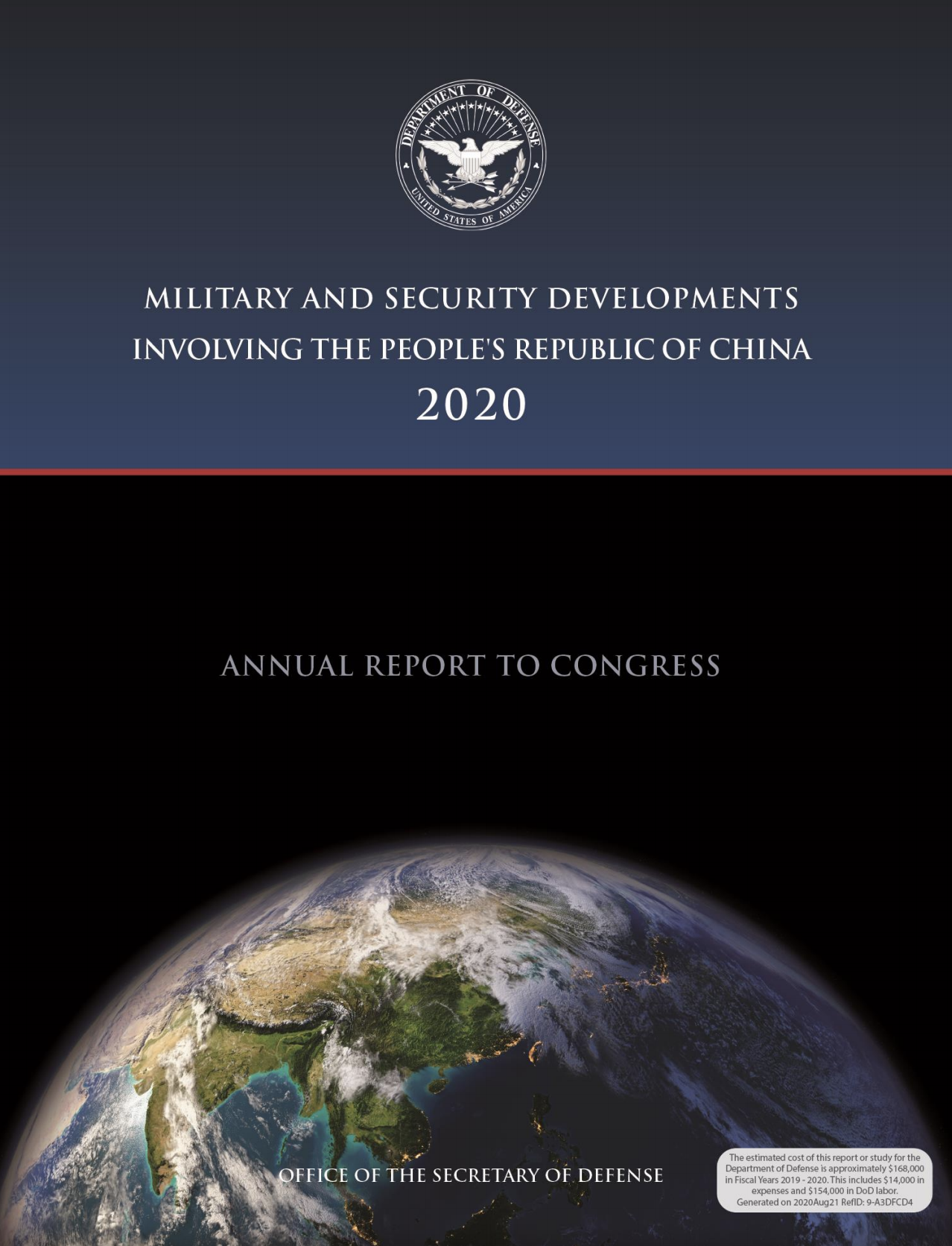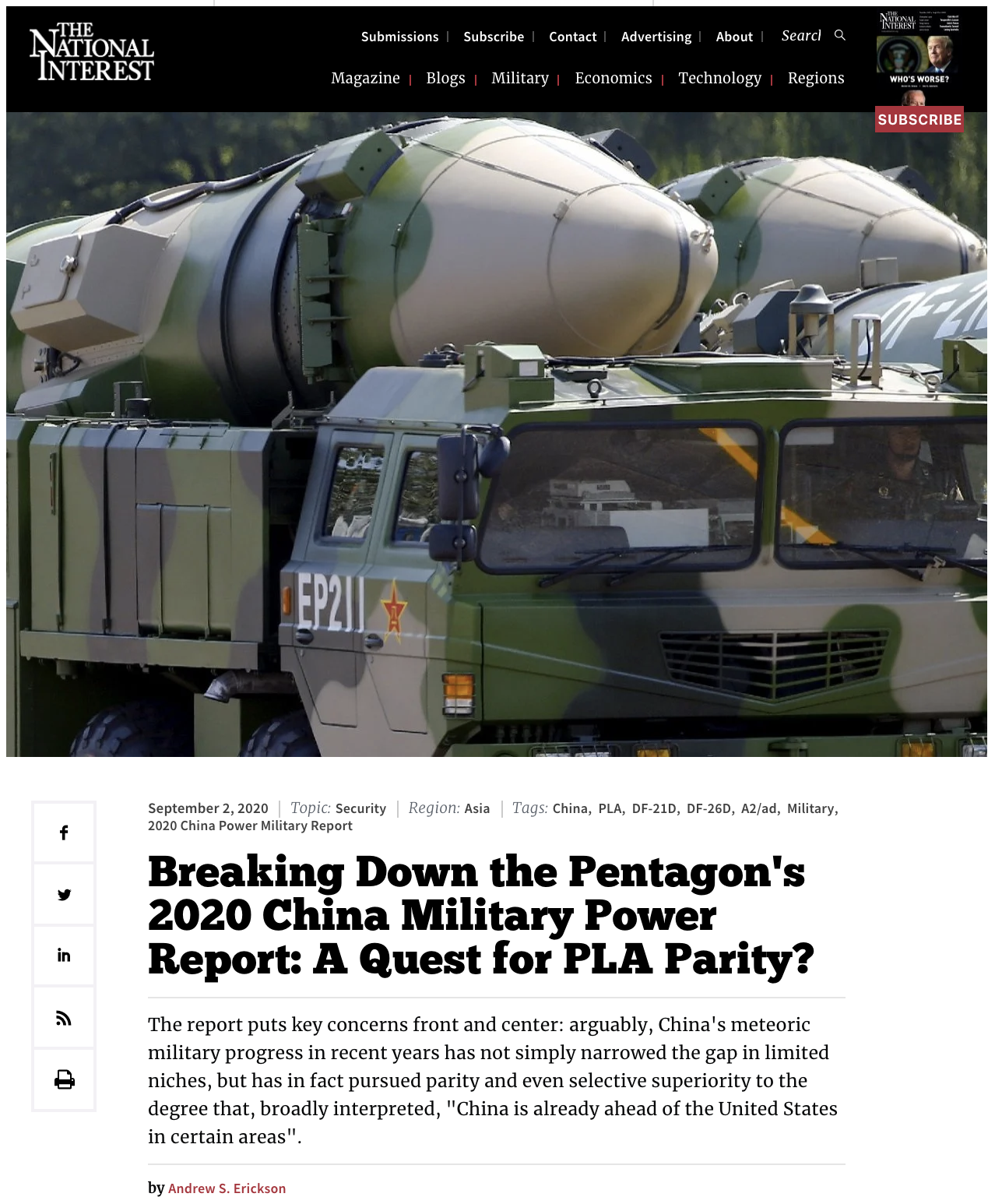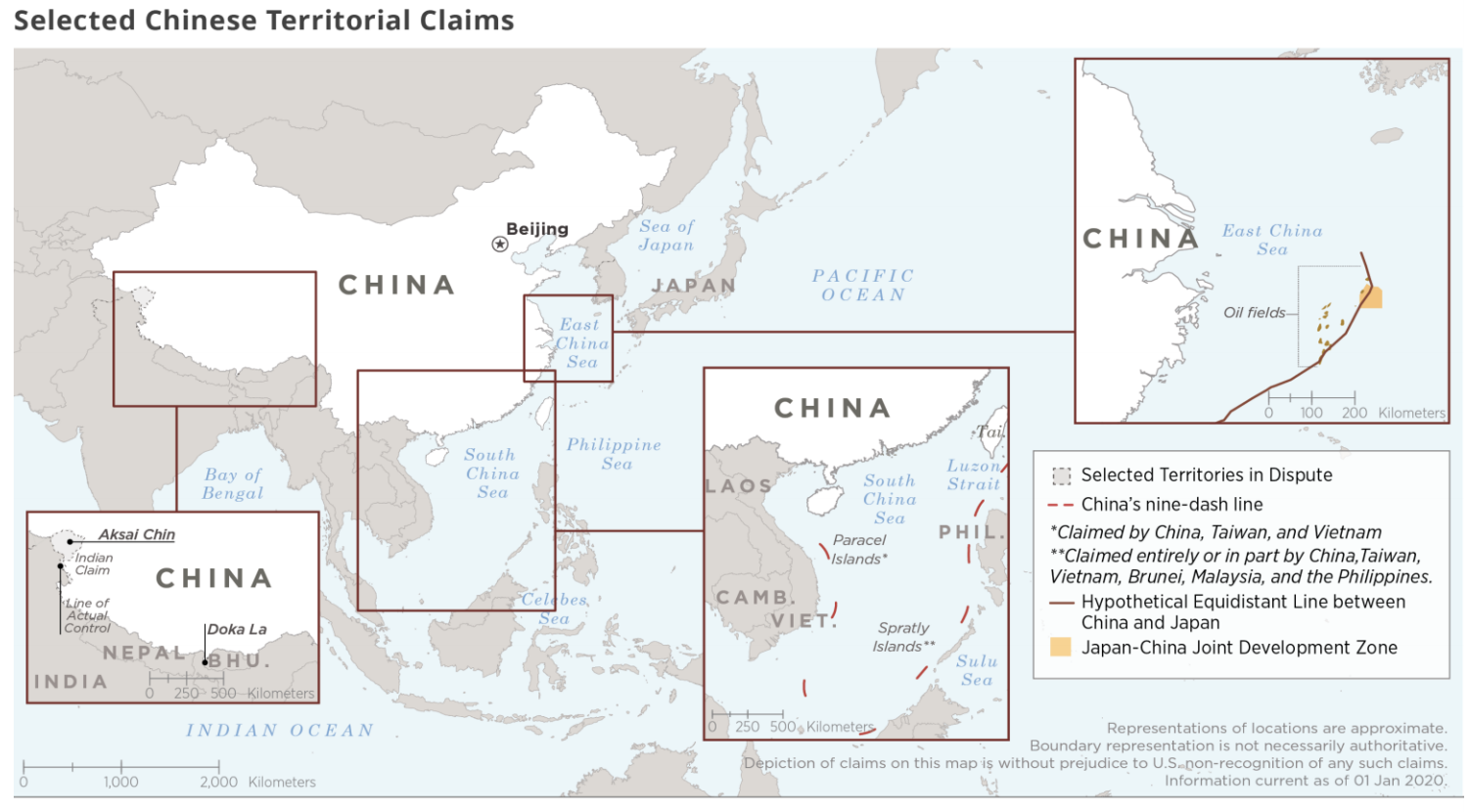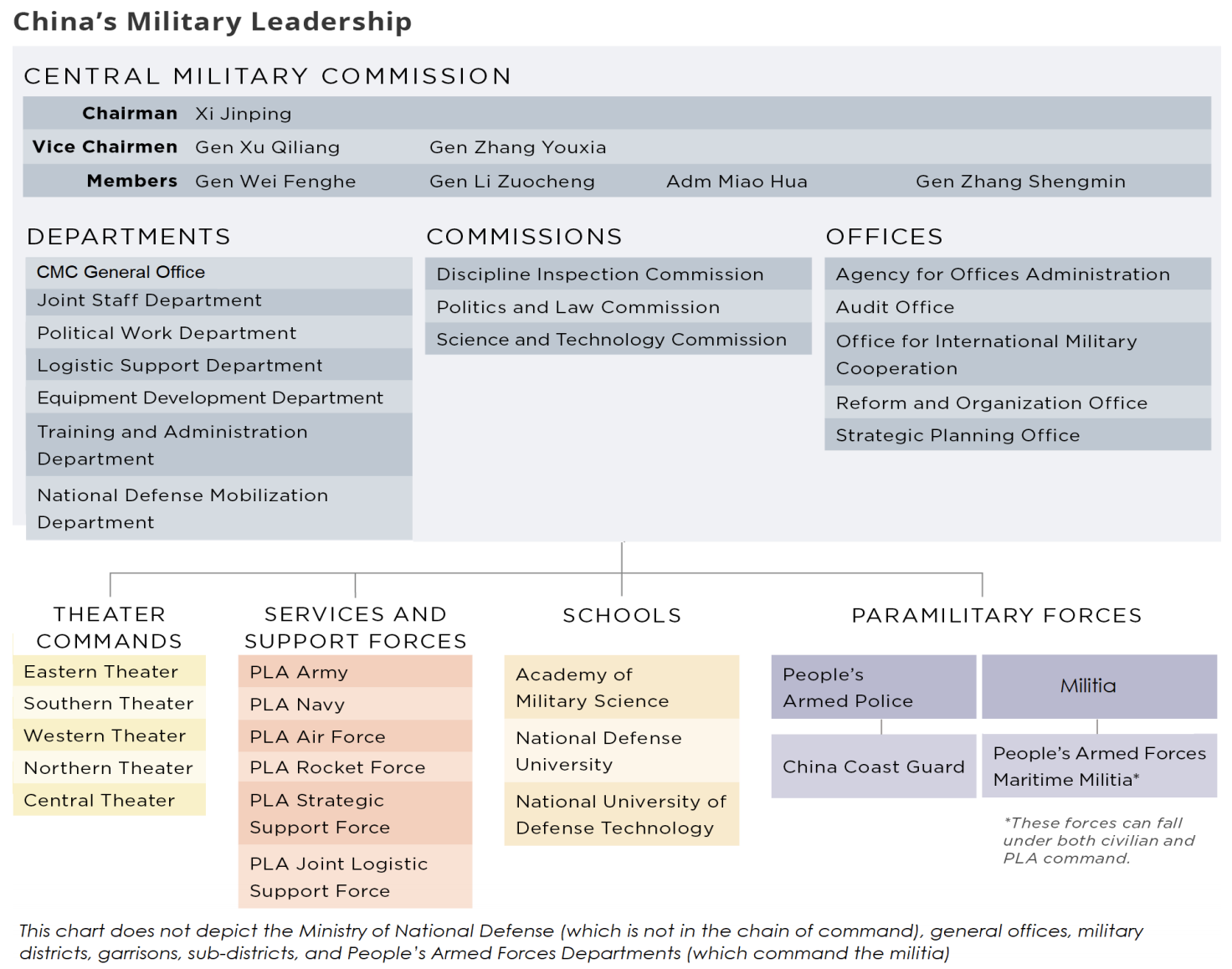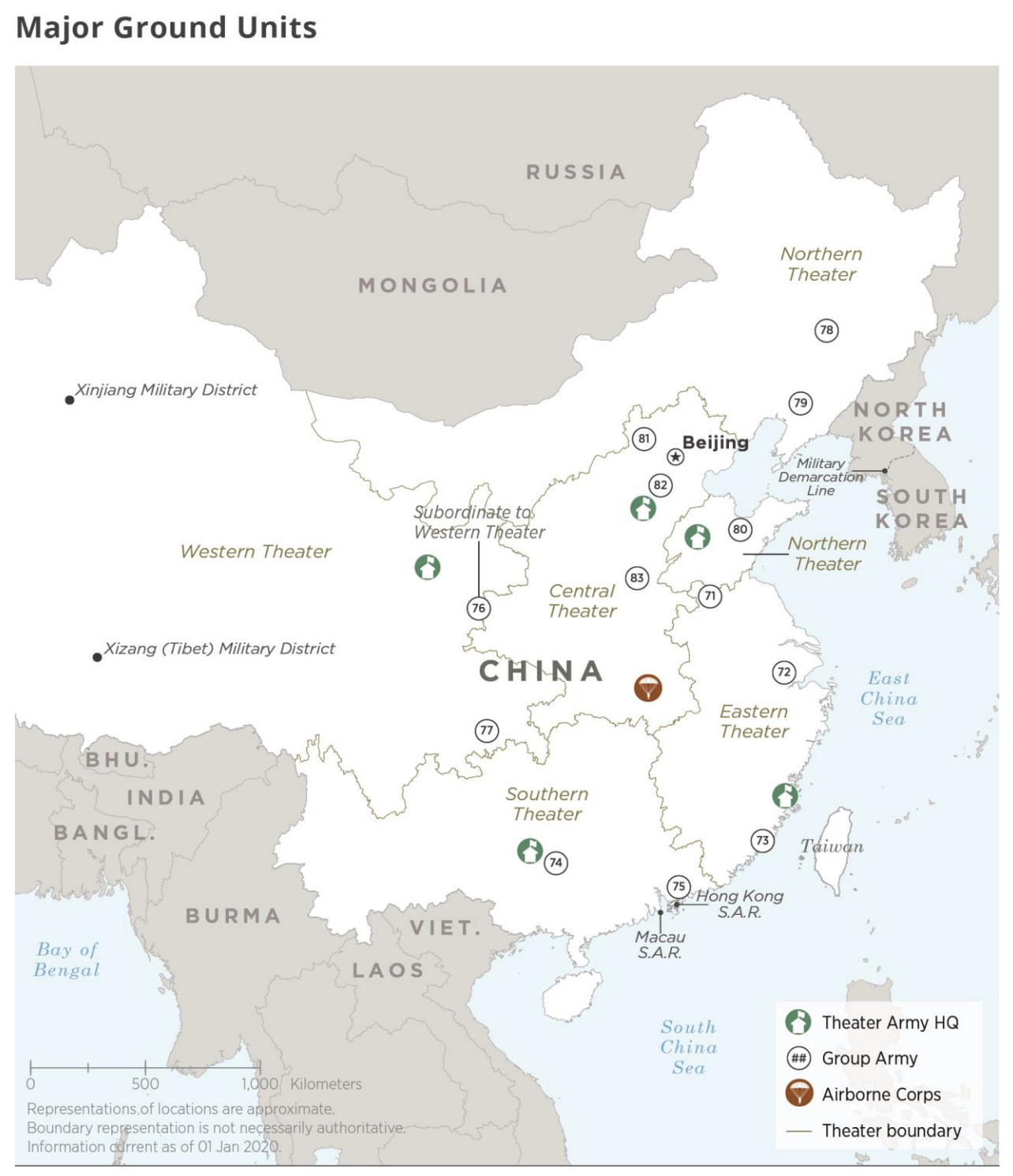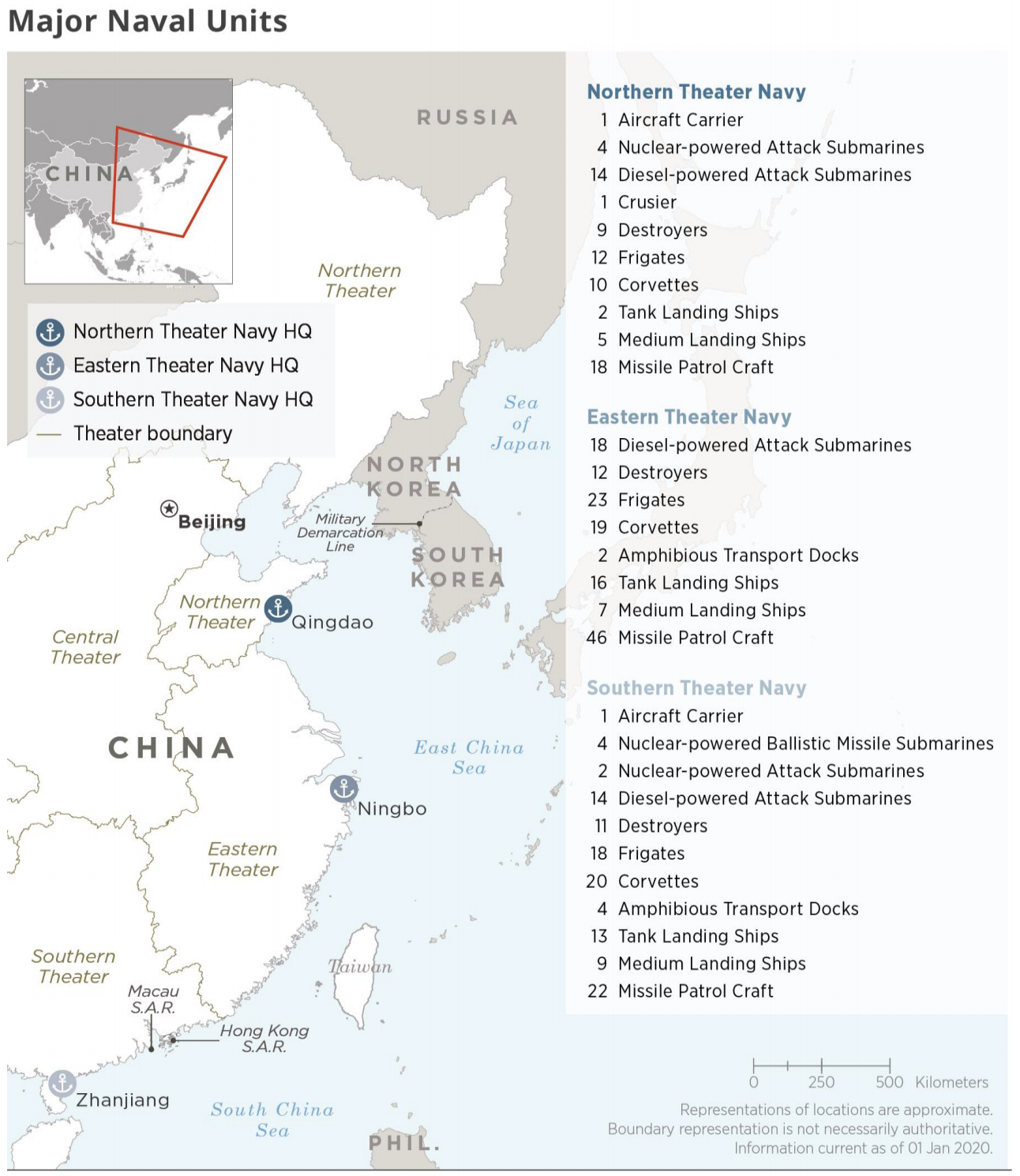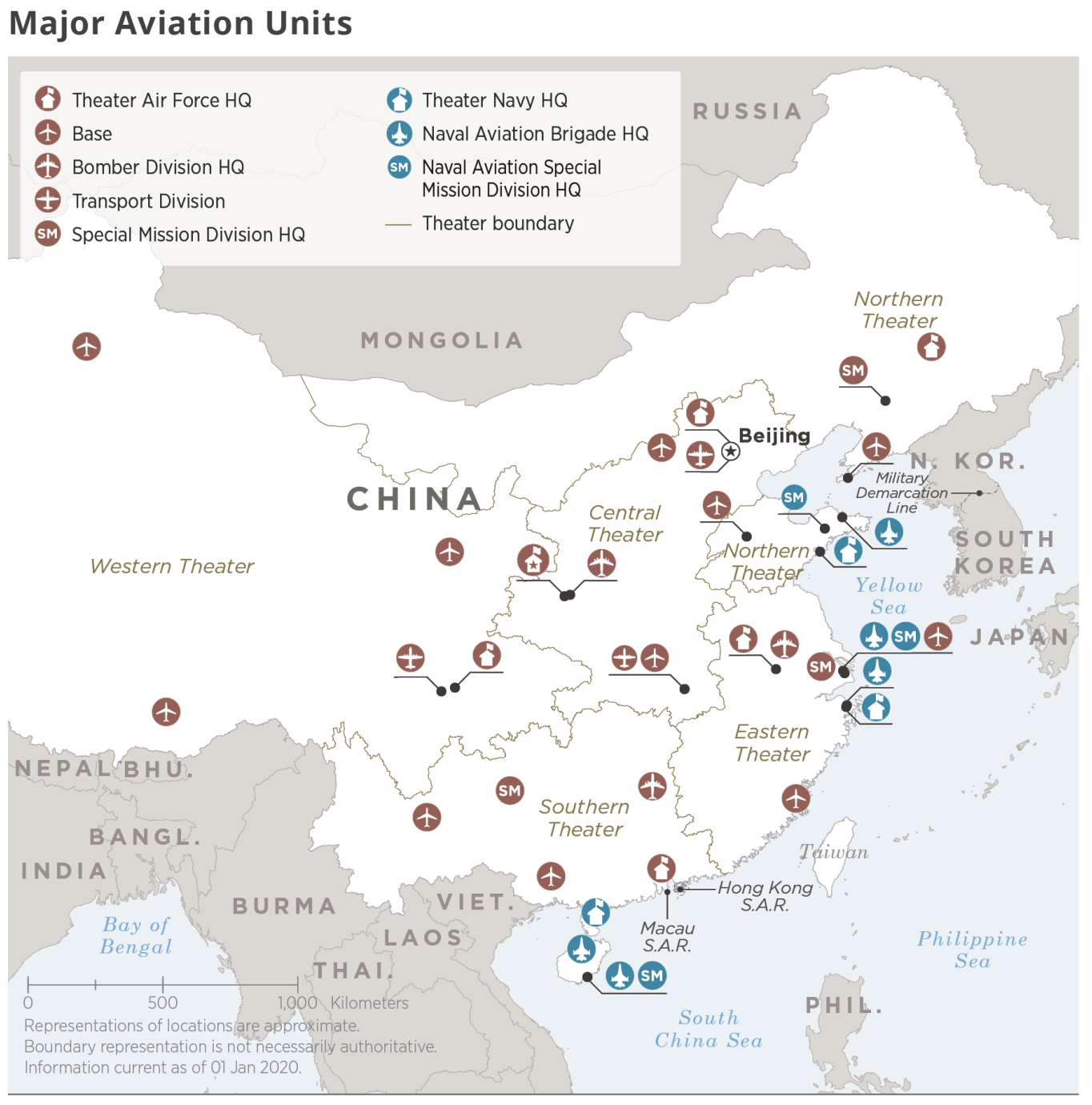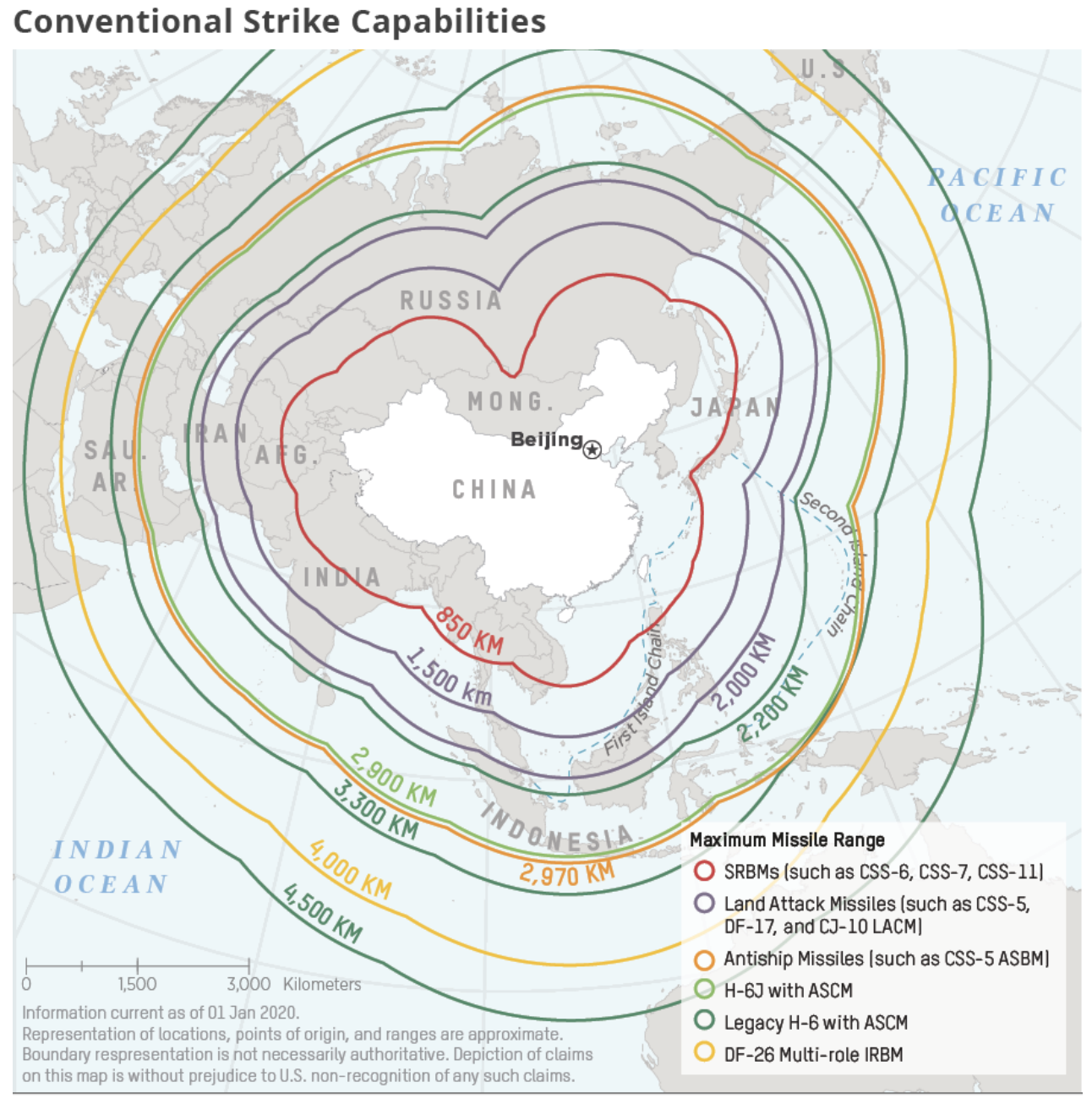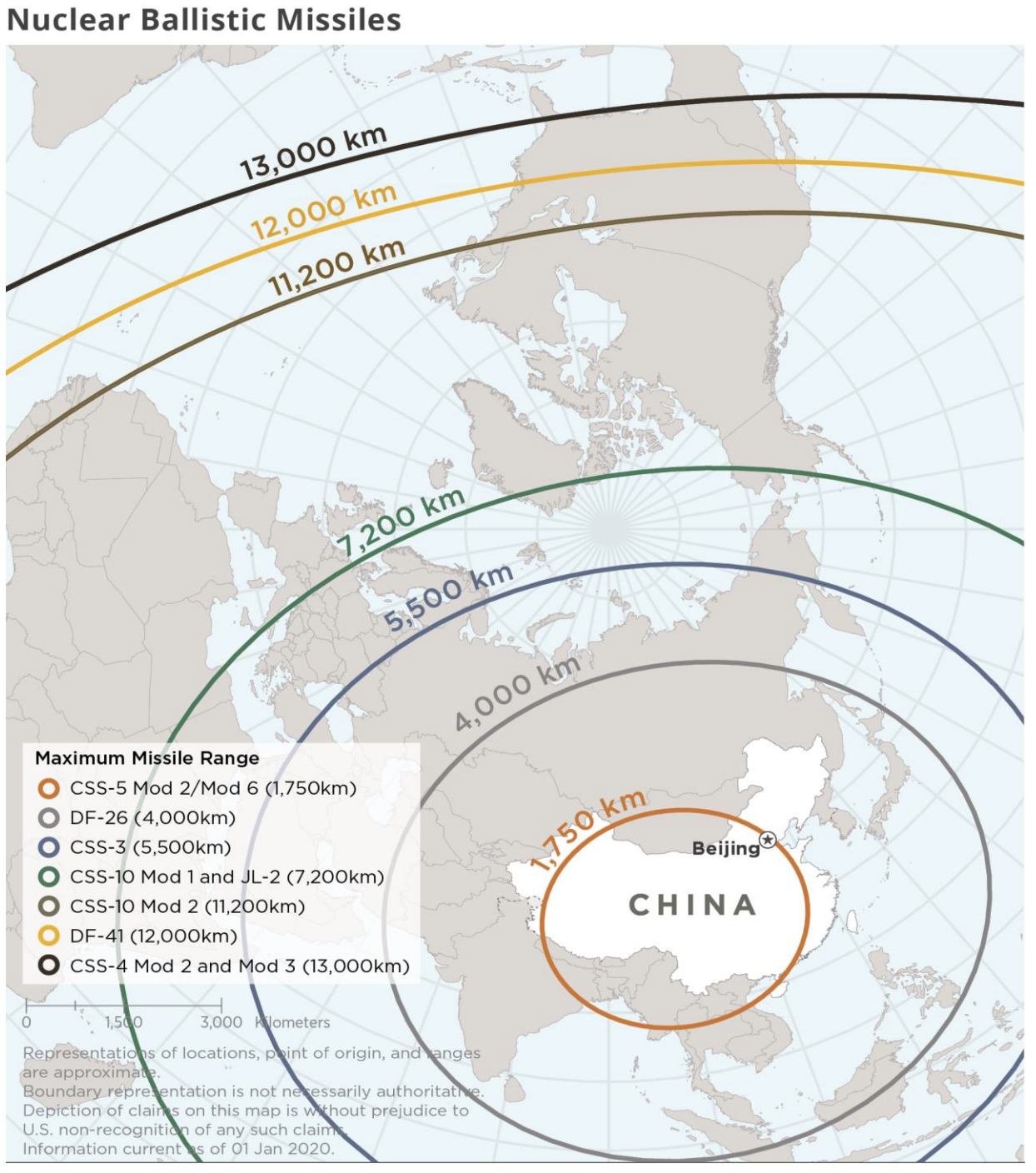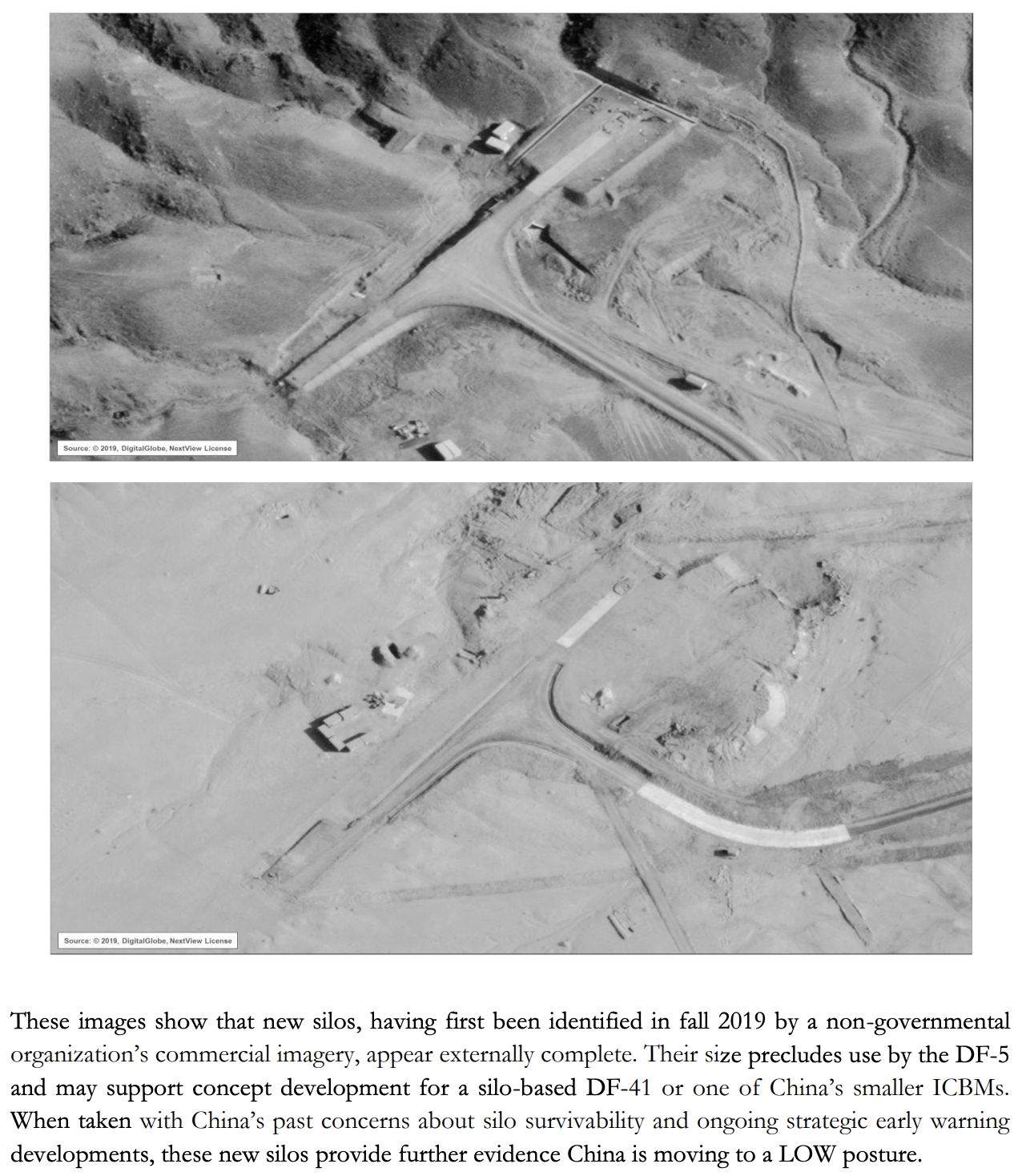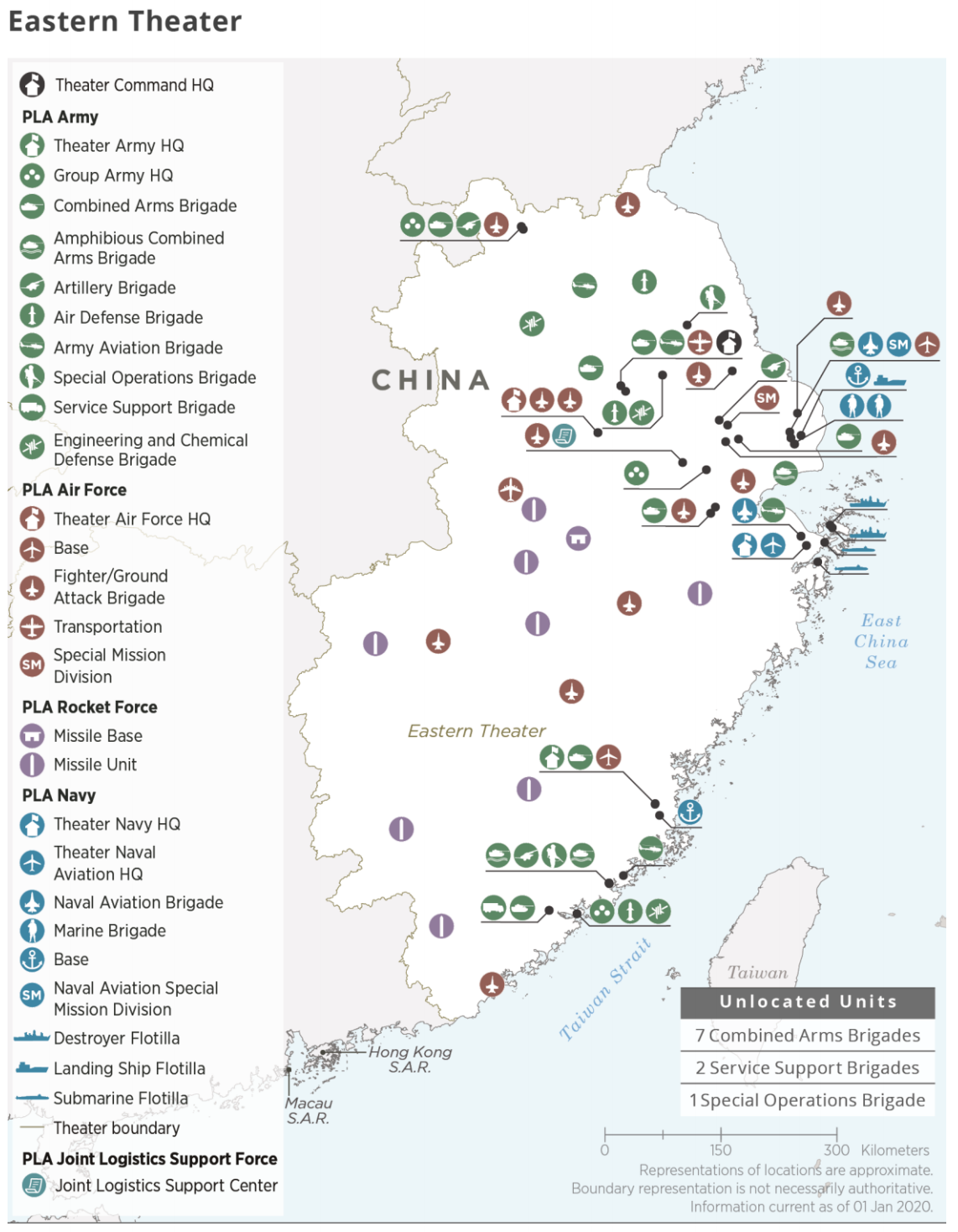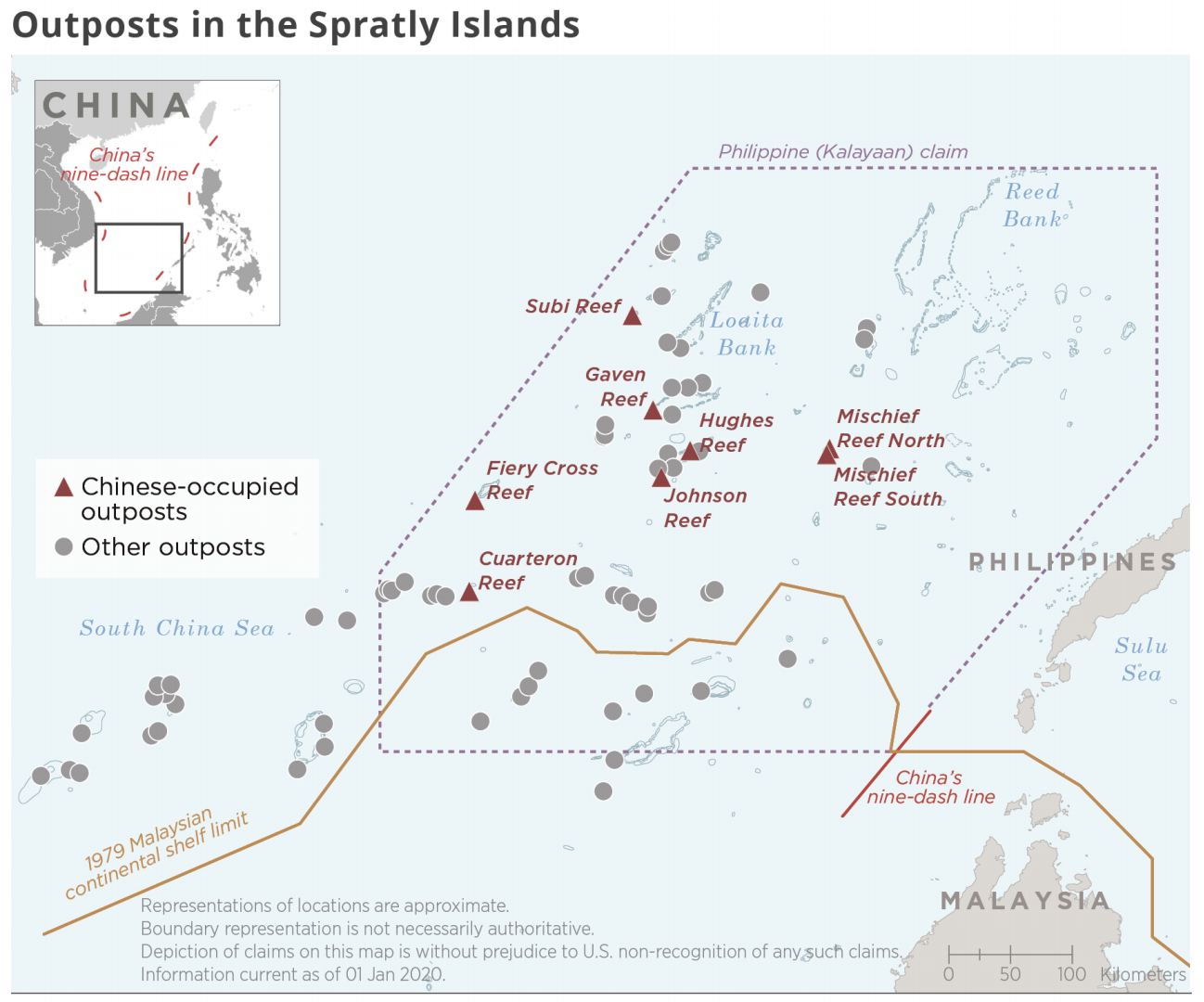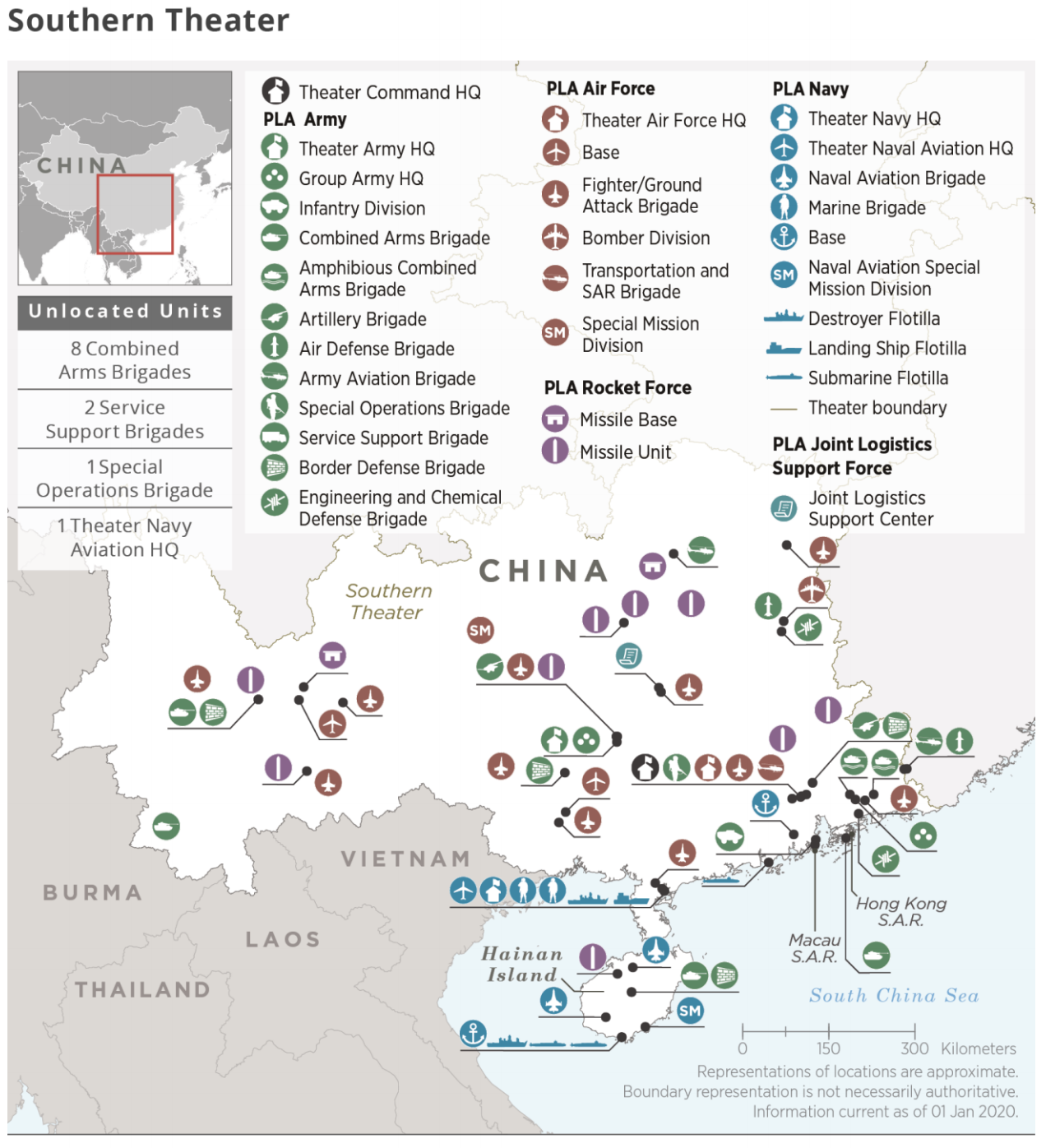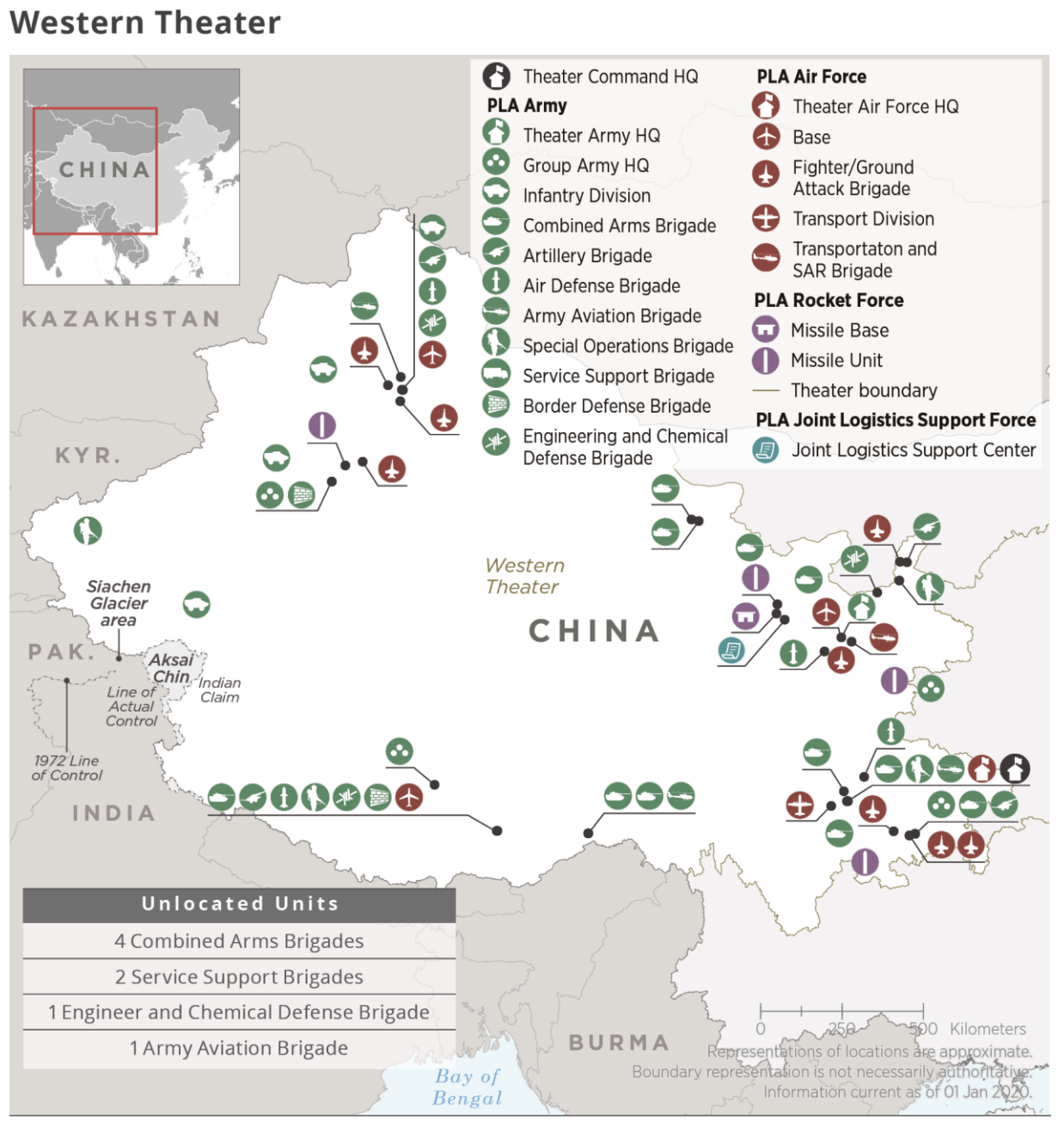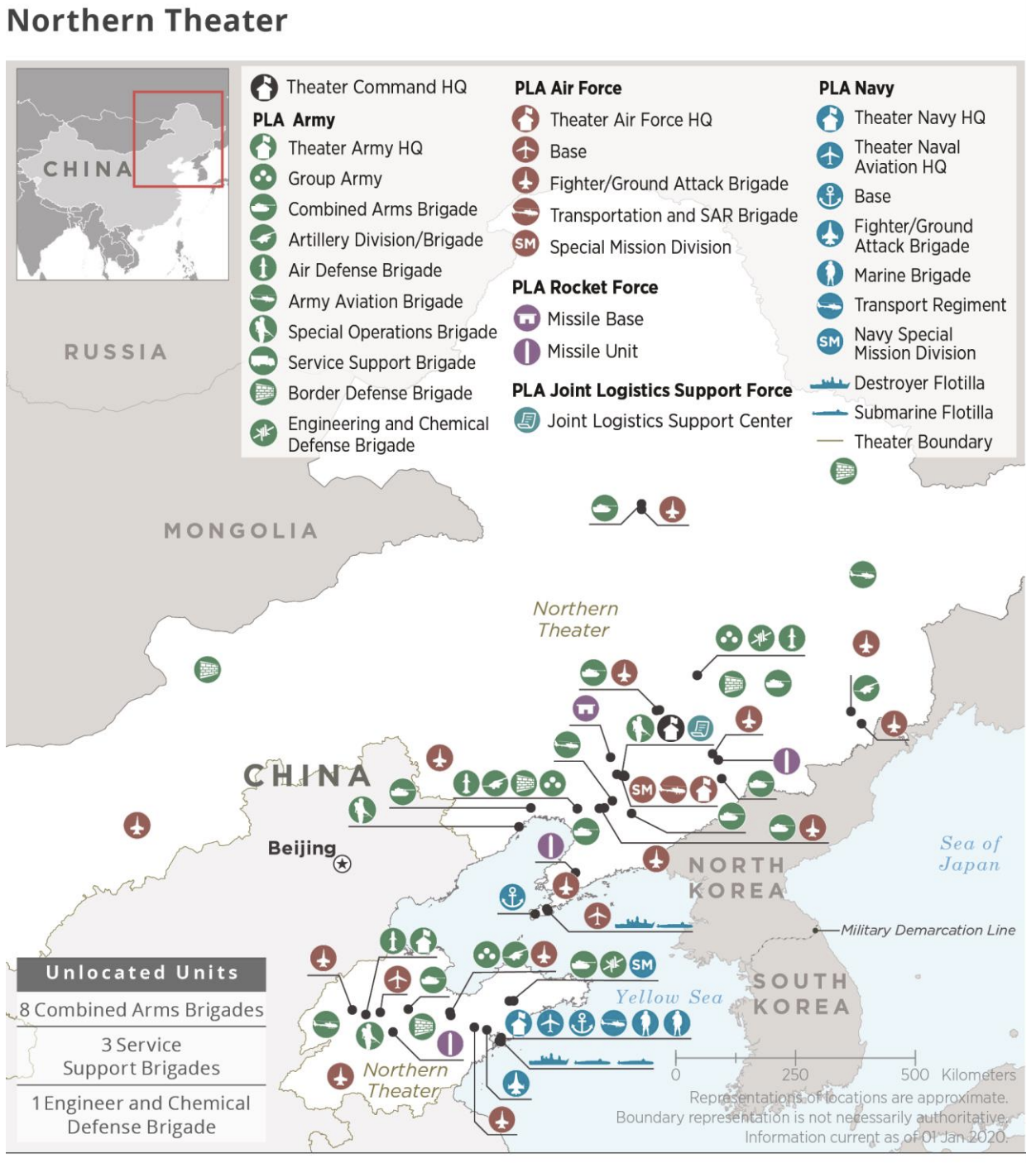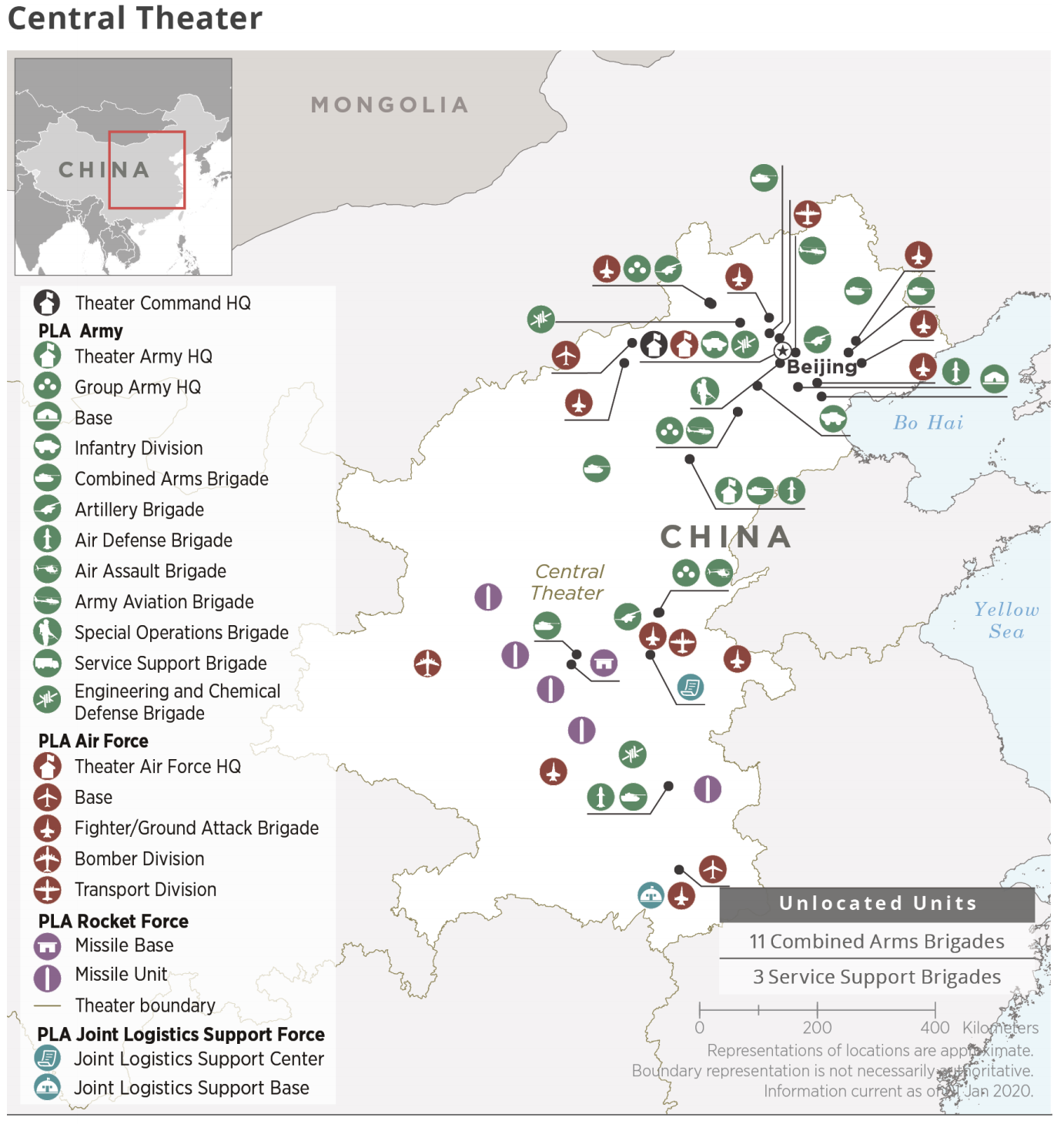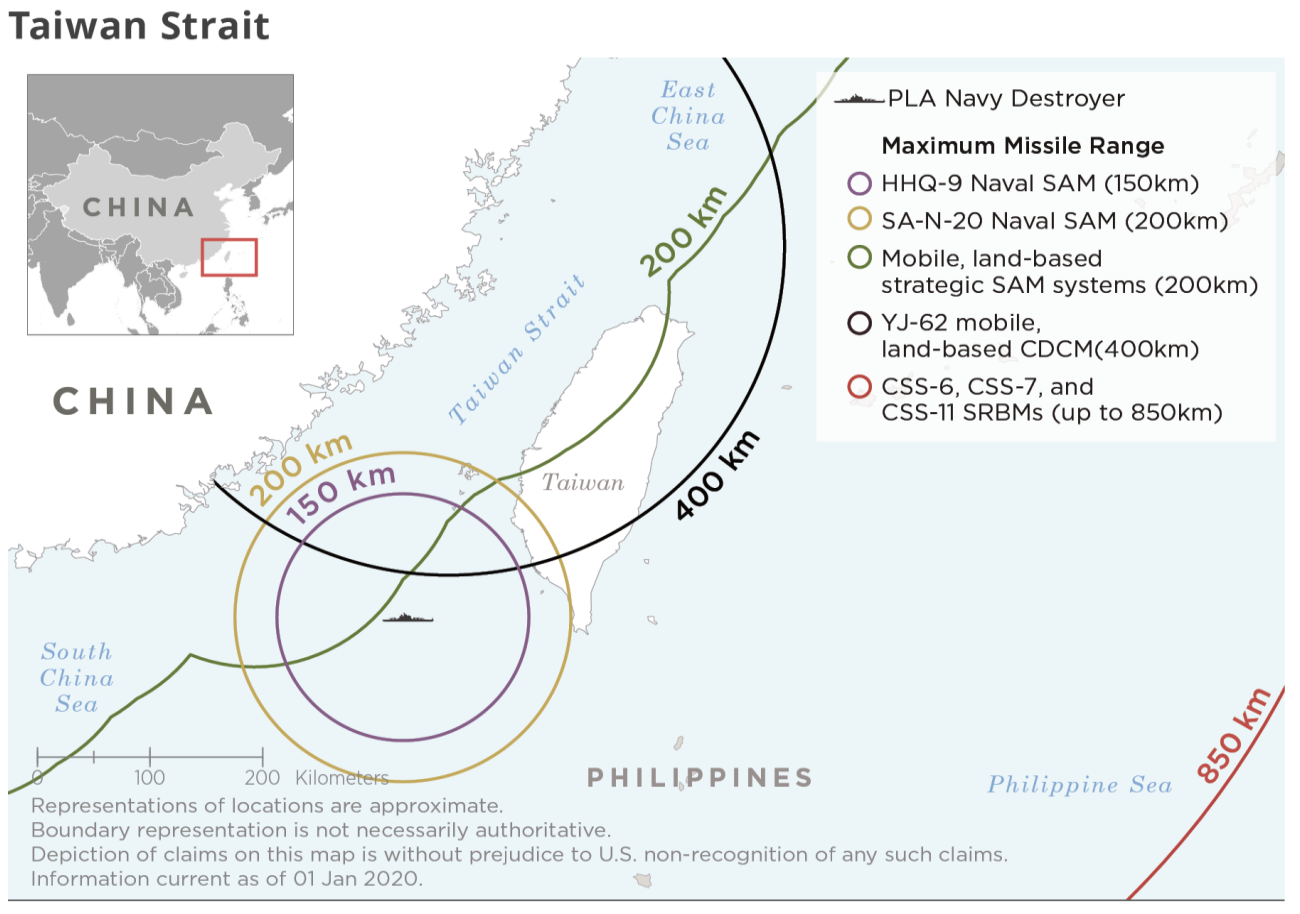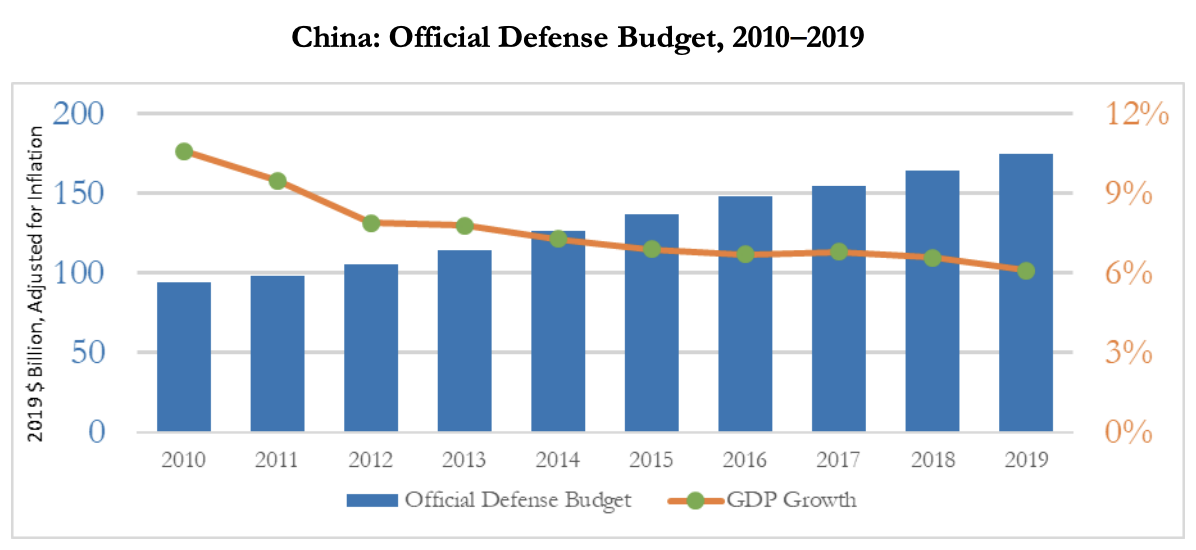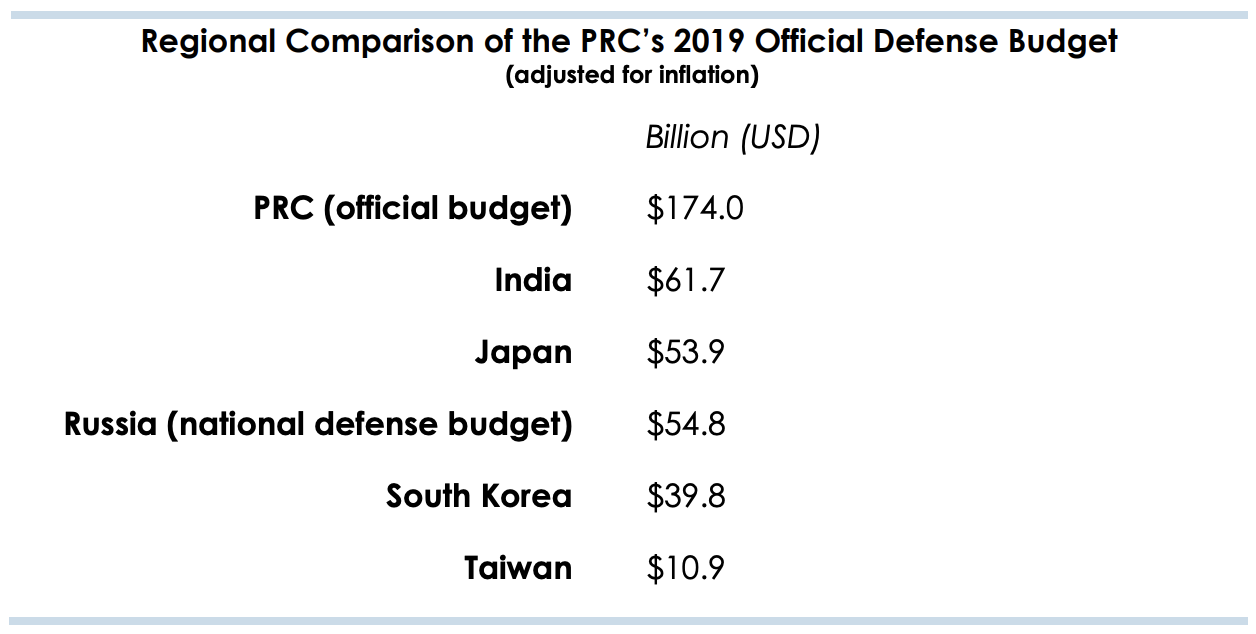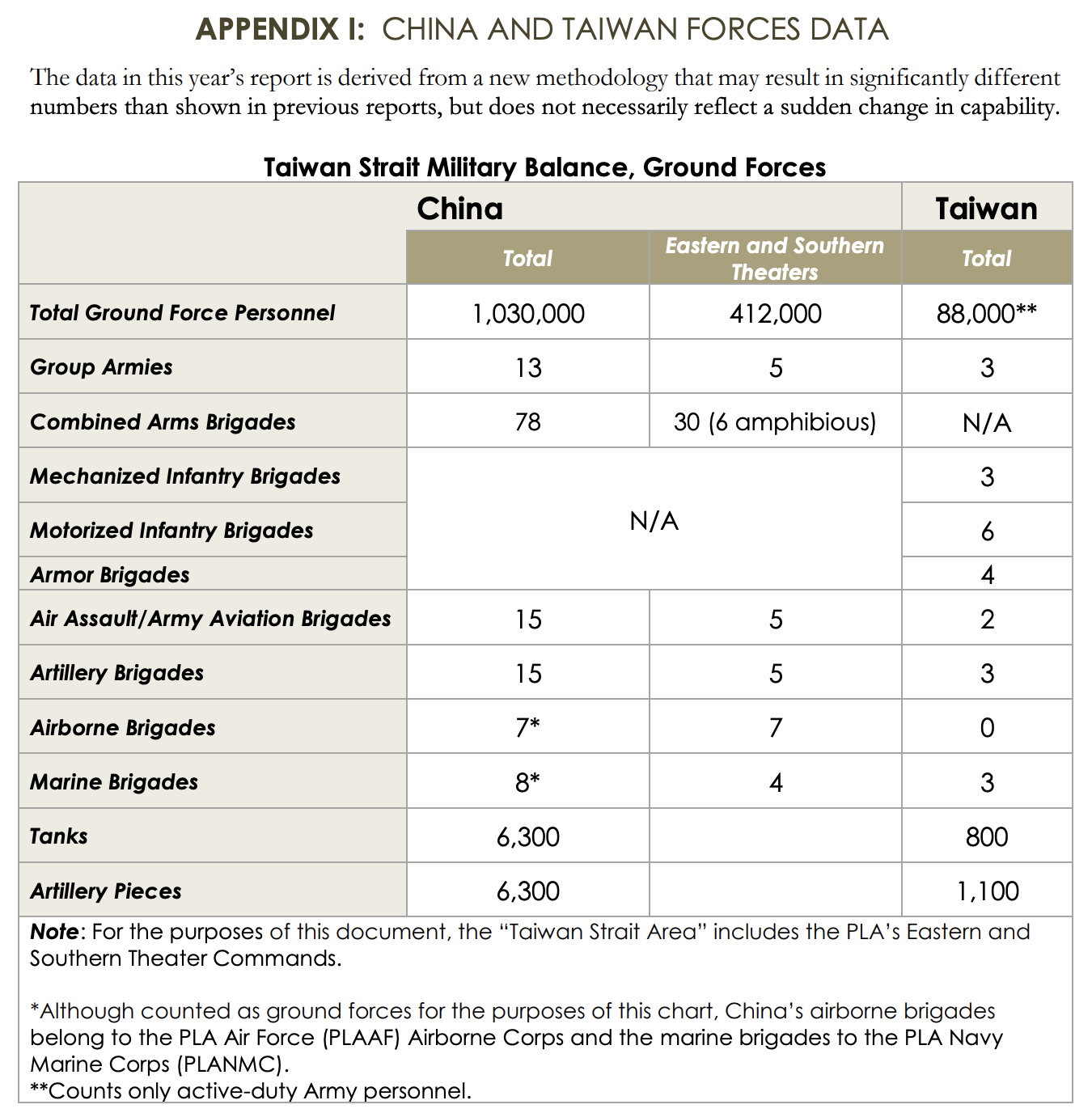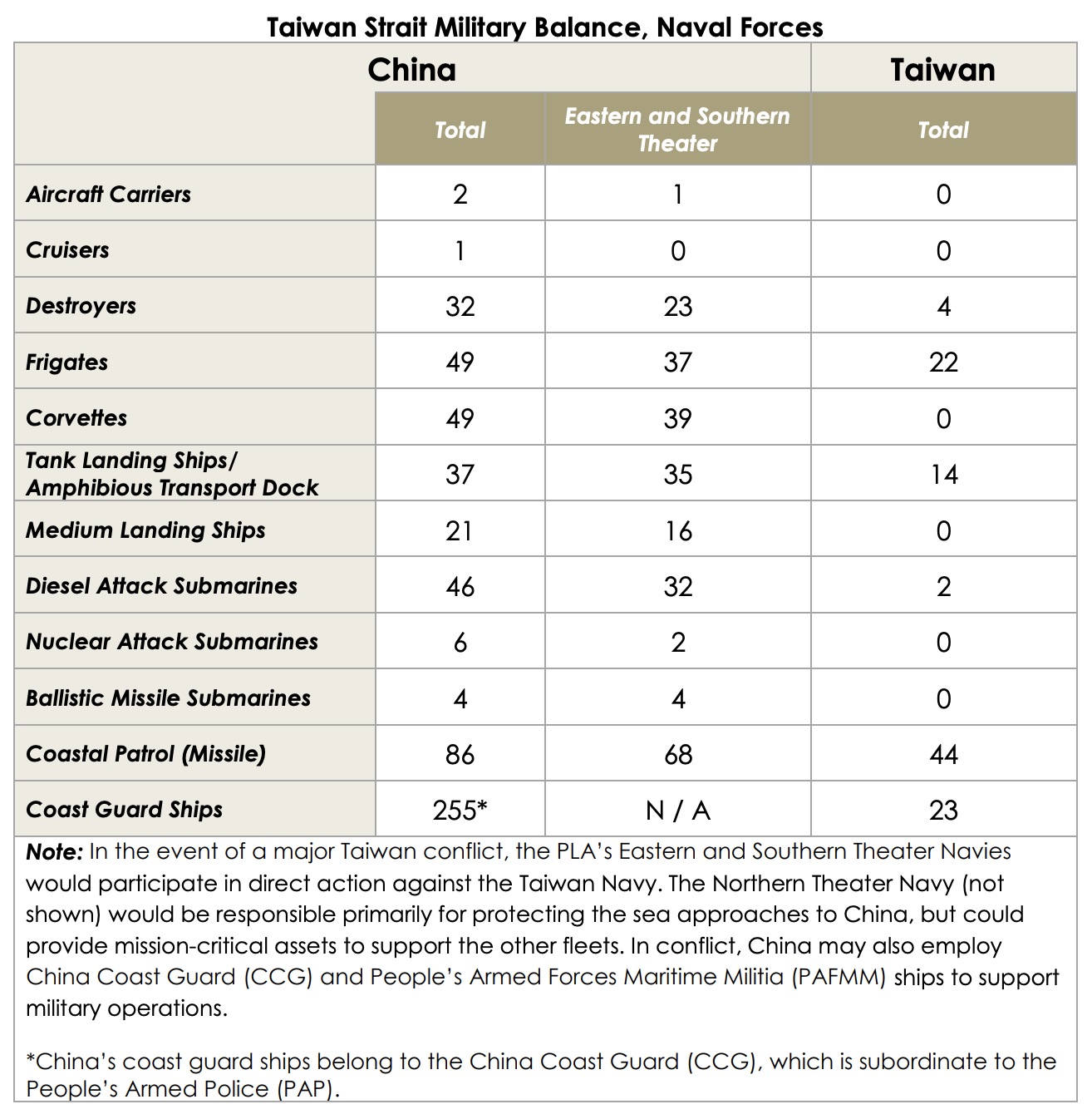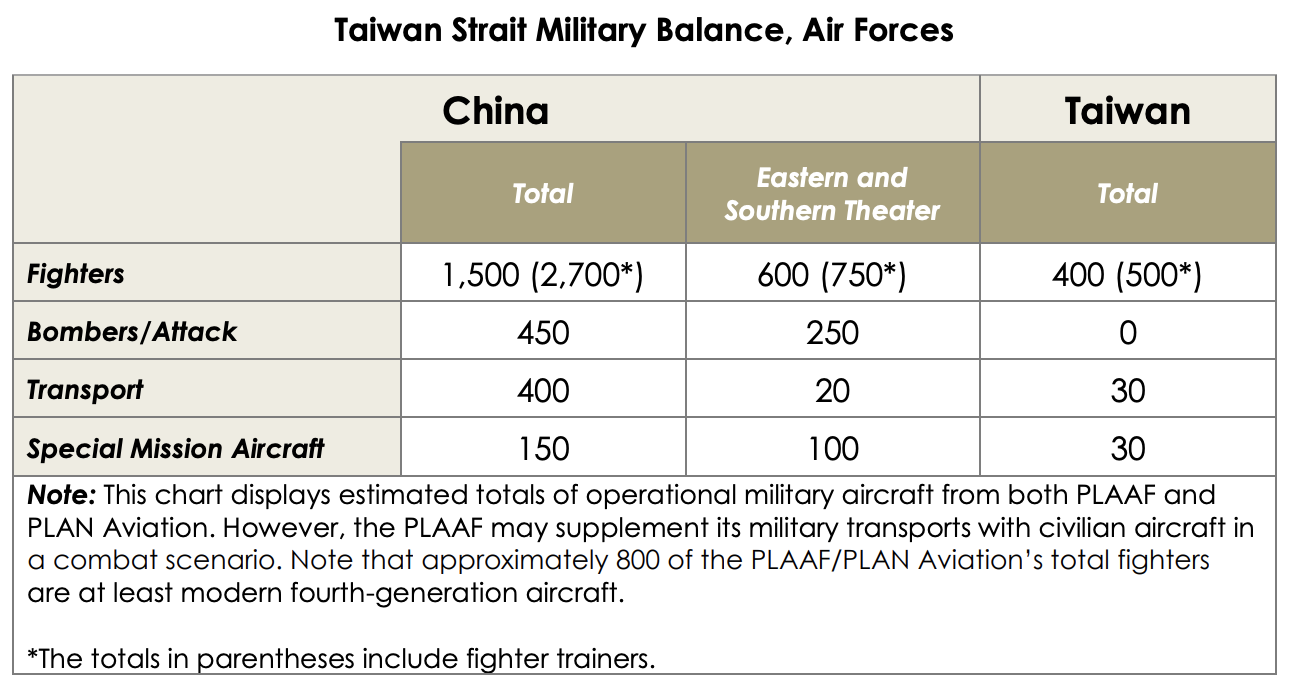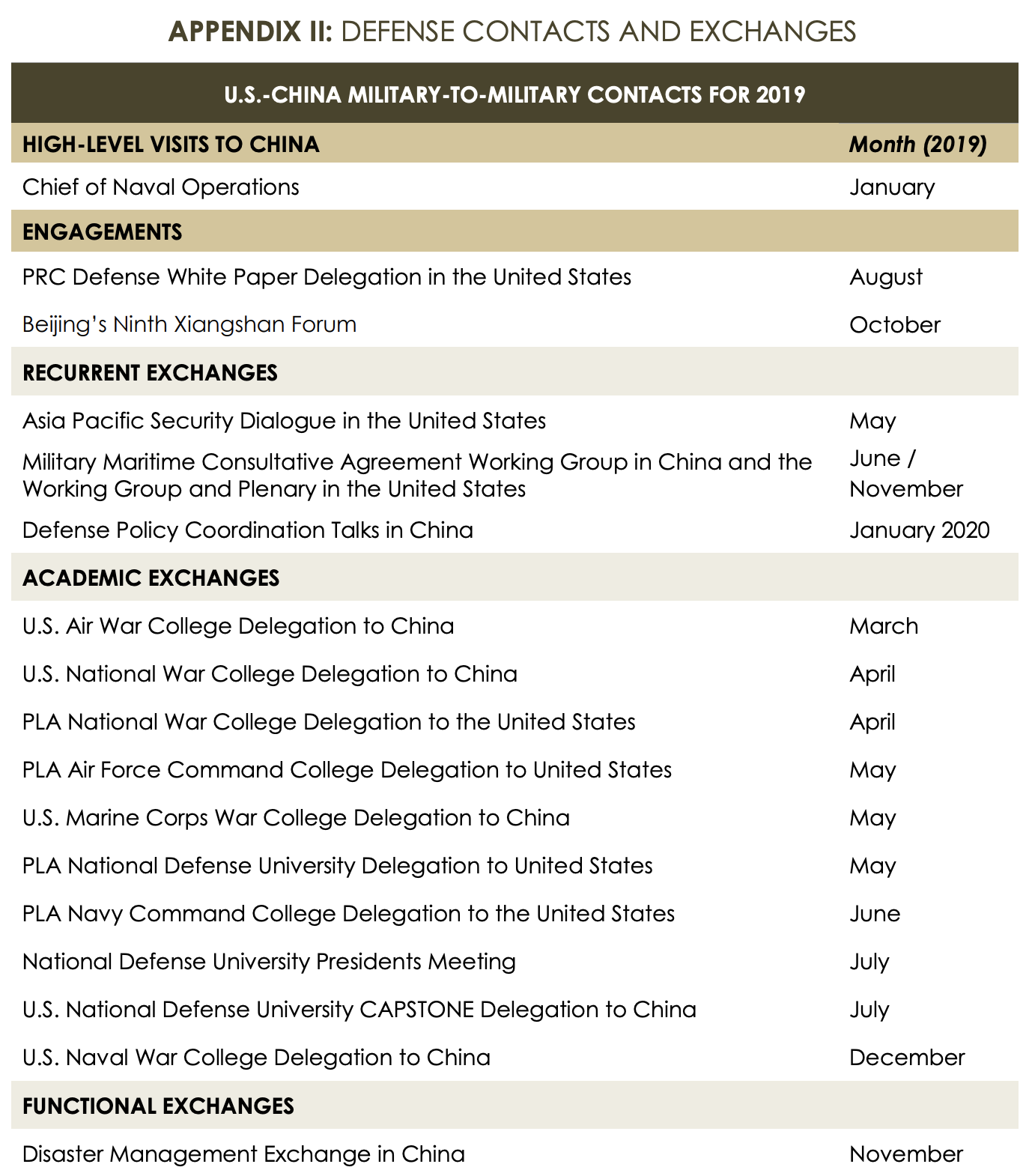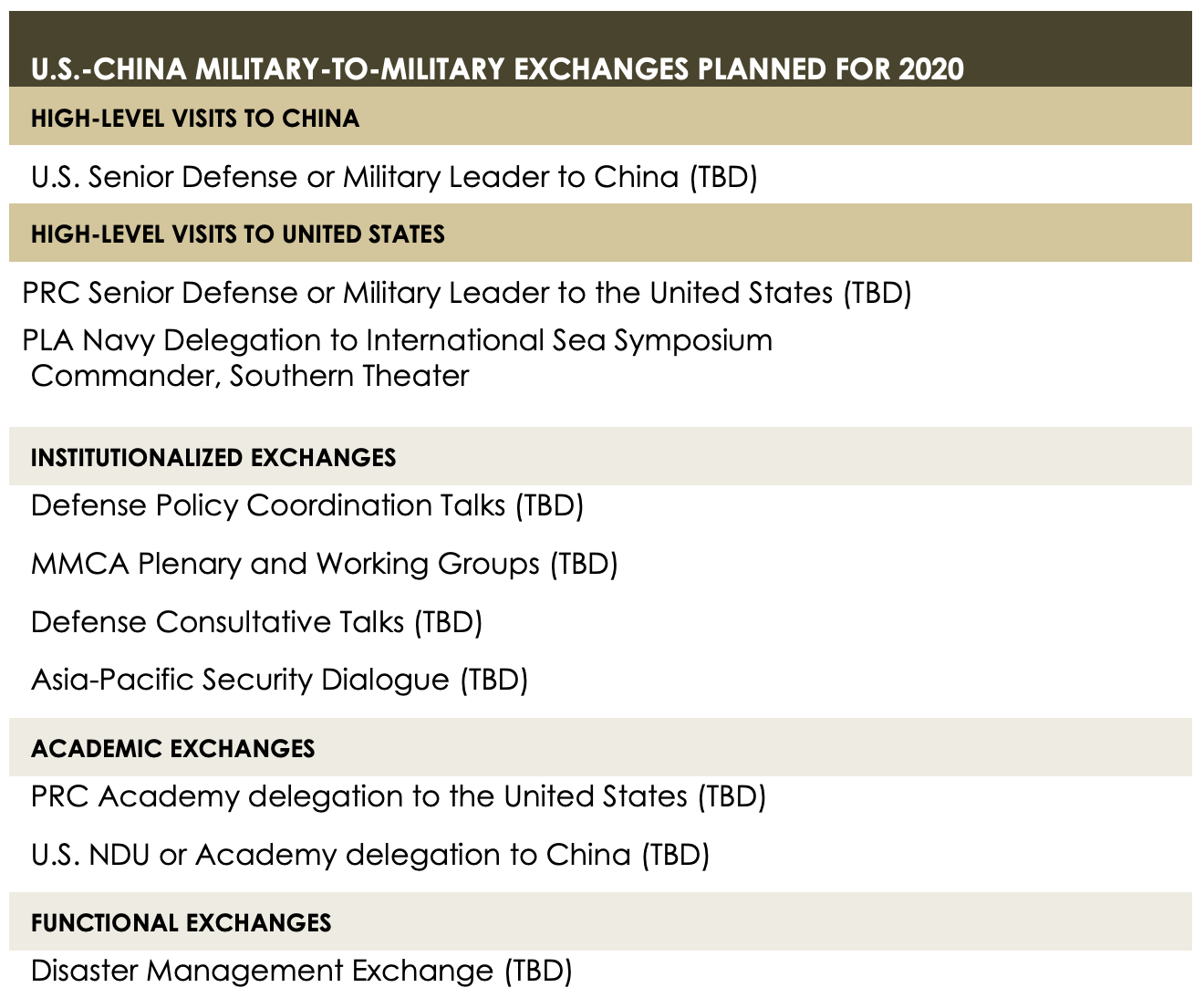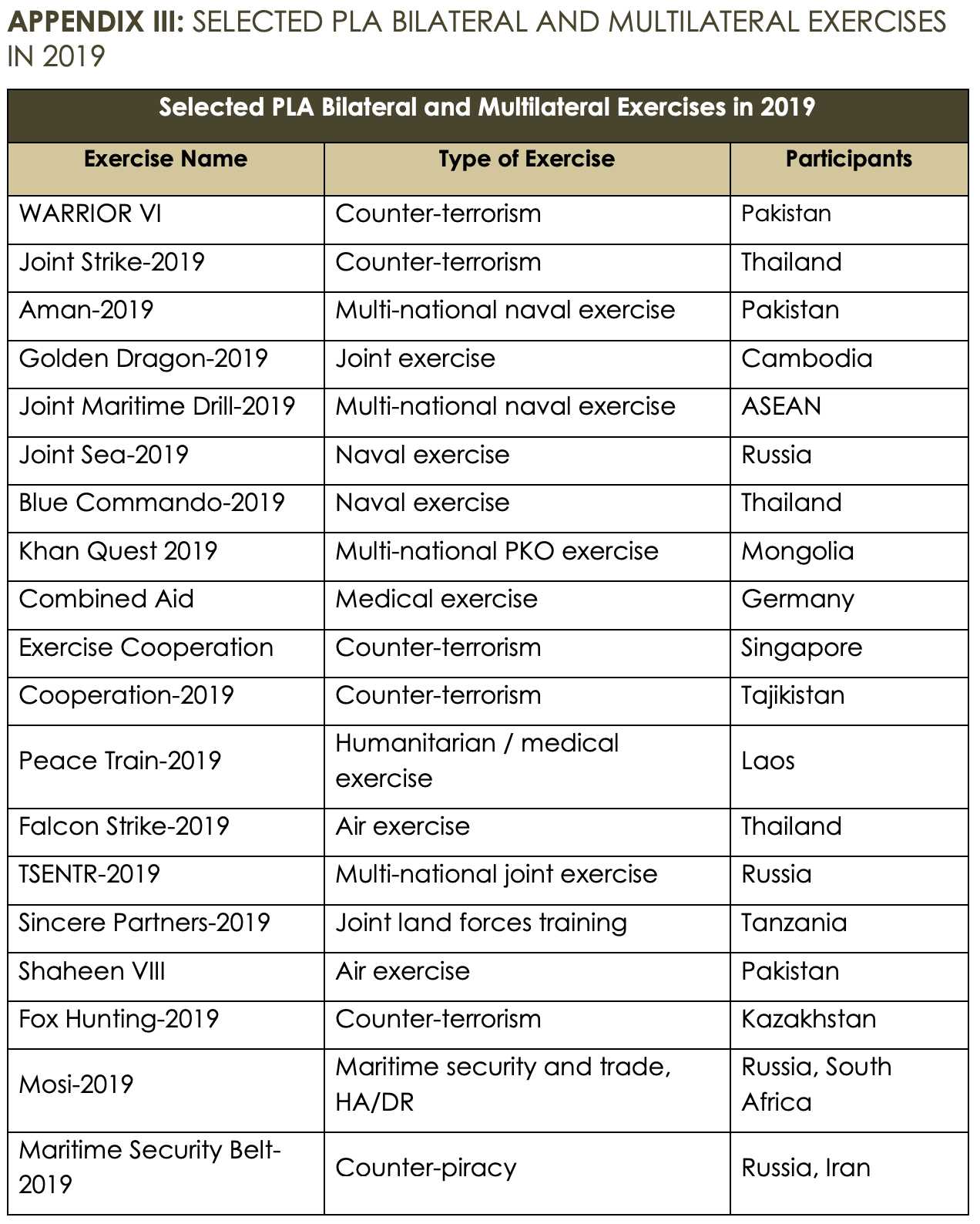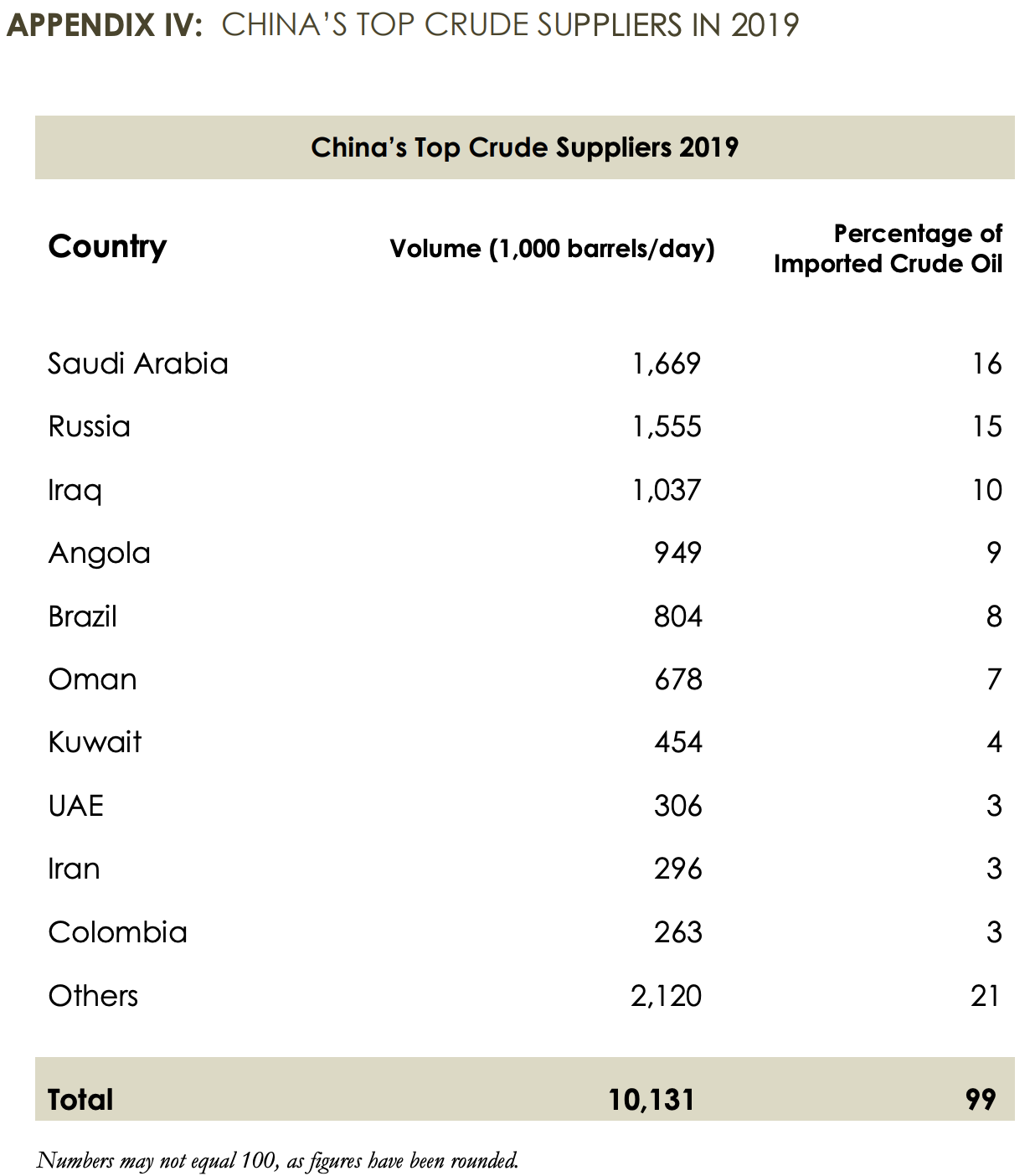Chad Sbragia, Deputy Assistant Secretary of Defense: “Press Briefing on the 2020 China Military Power Report”
Chad Sbragia, Deputy Assistant Secretary of Defense, “Press Briefing on the 2020 China Military Power Report,” 31 August 2020.
STAFF: Okay, good morning. Thank you, everyone, for joining us this morning for an interview with Deputy Assistant Secretary of Defense for China Policy Chad Sbragia, to discuss the department’s annual report, Military and Security Developments Involving the People’s Republic of China.
In a moment, I will turn it over to DASD Sbragia to make a few minutes of opening remarks. After that, we’ll go around the table here, give each of you an opportunity to ask a question. If time allows after we get through each of you, we’ll open it up for more questions. We have about 30 minutes or so in total this morning.
This interview is on the record, attributable to DASD Sbragia. As a reminder, this interview is also embargoed until the release of the report tomorrow, which is expected at noon.
With that, I will turn it over to DASD Sbragia. Thank you.
DEPUTY ASSISTANT SECRETARY OF DEFENSE CHAD SBRAGIA: Good morning, all, really appreciate you investing some time to join this morning. I’ll open with a brief overview of the key changes and the themes in this year’s report. I look forward to taking questions, obviously, as best we can.
DOD has provided the China Military Power report to Congress annually for about two decades now, and as — which has long served as a touchstone for authoritative information for Congress and the report’s other audiences. The report has taken on particular importance as the DOD continues to address the strategic challenge posed by China and continue to implement the National Defense Strategy.
What I’d like to highlight as the most significant changes in this year’s report, is the analysis of China’s strategy as articulated and understood by the Communist Party of China. It explains the logic of China’s strategy and offers insights into the motivations behind Beijing’s actions, policies and long-term goals as they relate to developments in the China — in China’s security policy in the military.
China’s strategy, as the report describes, seeks to achieve great rejuvenation of the Chinese nation by 2049. This strategy, led by the party, entails a determined pursuit of political and social modernity and includes efforts to expand China’s national power, perfect its governance systems, and revise the international order.
The Communist Party of China leaders characterize their strategy to achieve modernity as a national endeavor that will transform China and, in turn, the world.
The Communist Party of China’s leaders claim that their strategy requires China to, quote, “lead the reform of global governance system,” unquote, as they view the current system as antithetical to their socialist system and an intolerable constraint on their strategic ends.
The CCP’s leaders seek — see U.S. policy towards China as a critical factor affecting China’s national strategy, and increasingly views the United States as more willing to confront Beijing on matters where the U.S. and PRC interests are inimical.
The CCP leaders view the United States’ security alliances and partnerships — especially those in the Indo-Pacific region — as destabilizing and irreconcilable with China’s interests.
China’s strategy entails strengthening and adapting its armed forces to the long-term trends in global military affairs. This includes advancing a comprehensive military modernization program that aims to basically complete — as they say — basically complete military modernization by 2035, and transform the PLA into what they call a world-class military by 2049.
The CCP has not defined exactly what it means by its ambition to have a world-class military. Within the context of China’s national strategy, however, it is likely that China will aim to develop a military by mid-century that is equal to, and in many cases superior to, the United States’ military or that of any other great power that the Chinese view as a threat.
In terms of the PRC’s global military activities, the CCP’s leaders believe that China’s global activities including the PLA’s growing global presence are necessary to create favorable — a favorable international environment for China’s national rejuvenation. China is seeking to establish a more robust overseas logistics and basing infrastructure beyond its current base in Djibouti. China’s very likely already considering and planning for additional overseas bases to support naval, air, and ground force projection.
The global PLA military logistics network could interfere with U.S. military operations and those of our allies, and provide flexibility to support offensive operations against the United States.
This report allows United States policy leaders to have a deeper understanding of the strategic objectives of the People’s Republic of China and the Communist Party of China, and examines how the People’s Liberation Army serves as a tool of the party. This report serves as an essential tool for U.S. leadership as the department implements the National Defense Strategy in this era of great power competition.
I appreciate your time today and I’m ready to take your questions.
STAFF: Okay, all right. We’ll go ahead and start with Bob in the room.
Go ahead, Bob.
Q: Thank you.
I have a question on — the report mentions with regard to China’s nuclear force that you foresee them doubling the size of the warhead stockpile, which you say is currently in the low 200s, doubling over the next 10 years.
I’m wondering — are you talking about sort of their total warheads for all nuclear forces. What is that based on and — and is this — I think I believe I’ve heard this mentioned previously by officials, but — or is this the first time you’ve stated this publicly?
SBRAGIA: This is the first time that we’ve actually stated a specific number –
(CROSSTALK)
Q: — future number?
(CROSSTALK)
SBRAGIA: Yeah, future number, yes. So in the report, we do estimate the current state is in the low 200s. We’re certainly concerned about the numbers. Not just about the numbers however, and I think that’s to your point a little bit, is not only about the numbers, but also just the trajectory of China’s nuclear developments writ large.
We do believe that over the next decade, that China is likely to at least double the size of its nuclear stockpile in the course of implementing the most rapid expansion and diversification of its nuclear arsenal in its history, China’s history.
An ability to double the stockpile not only demonstrates a move away from their historical minimum deterrence posture, but places them in a position where they can readily grow their force beyond this number, which is part of the point.
Combined with a near-complete lack of transparency regarding their strategic intent and the perceived need for a much larger, more diverse nuclear force, these developments pose a significant concern for the United States and why we certainly included that in this year’s report.
Q: So just a quick follow-up then. You mentioned that — the concern by the U.S. about this. I mean, going to 400 is still, compared to the U.S., one could argue a relatively lower number. But you also say that this puts them in position to expand further. Do you have any reason to believe they will or why do you believe they would?
SBRAGIA: Well, part of the doubling effort is certainly going to entail emphasizing new processes, tools, and capacities, to get to that number, so this is — you know, this is not just the end product itself, it’s about the entire infrastructure to do so. And then ultimately where they go, especially in the context of their 2049 aspirations, is an important thing to monitor and we will.
Q: Thank you.
STAFF: Okay, thanks, Bob.
Let’s go to Tony Capaccio on the line.
Tony?
Q: Hi, sir. I’ve been reading these reports like since the first one came out, and this report had a lot of “China continues to build,” or “China continues to improve.” Can you walk us through what actually — what breakthroughs they actually — happened last year in — that — as opposed to just continued to?
SBRAGIA: Yeah, this is — this is an important aspect of — as you study and — and watch the PLA is — is that it – you know there’s two characteristics. This is the same characteristic of any aspect of China that you watch, is as — as commentators often observe, which is there’s both great change and great continuity in it — all things that the Chinese pursue, and in this case is – there’s great continuity in terms of where the Chinese aspire to be at, their longstanding national rejuvenation goal by mid-century is — is a — is a prime driver for them.
What you have seen most — within the report, most decidedly, is the ongoing reforms to the PLA. So in the PLA’s own voice, the most substantive changes that they’ve made is how they’re closing out this current round of reforms to the PLA itself.
The PLA, as we talk to them and as they reported in their 2019 Defense White Paper, is the most substantive aspect of what they’ve done is — continues to be not just the materiel advancements that they make in terms of capability but the conceptual frameworks that they’re changing, the reorganization of the PLA writ large, particularly the tightening up in their ability to manage and drive advanced concepts and capabilities downstream.
So for us long-term, it’s – it’s about their — or in terms of last year specifically, it’s about just the nature and — and content of the reforms that they’re undertaking.
Q: Okay. Quickly, Taiwan question. For the second year in a row, you’ve said that Taiwan’s defensive capabilities have eroded or been negated by many of China’s modernization efforts. What’s the implication to — of — of that conclusion to the Taiwan-China military balance?
SBRAGIA: No, certainly there’s — the PLA activities are destabilizing and significantly increase the risk of miscalculation. The entire aspect of — of why the United States is attentive to this, both codified through Congress and then obviously within our own National Defense Strategy, is that our policy has been consistent since 1979 under the Taiwan Relations Act and in 1982, President Reagan established a policy of conditioning arms sales to Taiwan based entirely on the threat posed by the PRC.
As we watch what the PLA is doing, it is continuing to develop at an incredible rate and so that balance across the straits is — is certainly intensifying. It’s not lessening, it’s not staying static. So in this case, it’s – it’s an aspect of watching the Chinese develop both advanced capabilities and concepts but also just the sheer quantity of what the PLA is doing. That is always going to disadvantage Taiwan as — if they stay static.
Q: Okay, thank you.
STAFF: Again, Tony, thank you very much. Let’s go to Idrees from Reuters, thanks.
Q: Yeah, thanks for that. I had two quick questions. One was specifically about doubling the nuclear stockpile. Is that solely based on an assertion you make lower down with, say, if China has enough fissile — fissible material to at least double its warhead stockpile or is it based on more than just how much fissible material they actually have available?
And — and — and secondly, the one thing that — that the report doesn’t address is what would happen with this nuclear stockpile or warhead numbers if China were to, in some way, shape or form, join New START or some sort of agreement with the United States and Russia. Is that something you’ve looked at or believe may alter the numbers at all?
SBRAGIA: Yeah, I think the — you know, the aspect of looking at their numbers and they’re doubling is — as we mentioned — and — and I think it is touched upon in the report a — a bit is just about what this entails in terms of having to change their infrastructure to — to get to these — these numbers. Some of that can be done with what they have capacity currently on hand and some of that will require certainly new aspects of — of development to — to obtain those numbers.
Now how that bears on this — on, as you noted, the trilateral — or the proposed trilateral nuclear arms control arrangements. The United States believes it is time for China to participate in nuclear arms control. While China has praised agreements such as the New START and INF, it has also sought to avoid participating in the arms control itself.
At some point, it — we — we think it is going to be prudent for us to do so, as the right thing for any nation that — with these kind of capacities to achieve. China needs to halt the upward and destabilizing trajectory of its nuclear buildup and work closely to — to reduce nuclear risks.
While China has not chosen to participate in the recent — recent proposed trilateral arms control discussions, its refusal to engage will not belabor U.S. efforts to begin shaping a new era of arms control with Russia. China’s interests will not be severed by failing to come to the table, however — or not be served, I’m sorry, by failing to come to the table.
The United States is willing to make progress with Russia while waiting on China to recognize its interests in behaving like a great power and a responsible nuclear weapons state by pursuing negotiations in good faith.
China needs to hear this message. We have told that to them publicly and privately and certainly consistently, not just from us but from others. We continue to call upon the PRC to uphold its responsibilities as a world power. As the PRC works towards their goal of great power status by 2049, the department continues to encourage our allies and partners to call on the PRC to live up to its responsibilities that go with its status. We think it’s crucial and we will continue to message the PRC about the importance of these negotiations and PRC’s place in the world.
Q: Sure. I mean, I agree that’s all in — in the report but from your perspective, if China were to be a part of any trilateral agreement, would that doubling of warheads that you’ve talked about be different, would it be lower? How much lower?
SBRAGIA: Well, of course those are things that you would have to — that would come out on the table during negotiations. I think the — the — the key starting point is that you have to begin negotiations before you understand where you might aim at, at the end point.
Q: And on the fissible material, would it — that be only thing you’re basing the doubling on or — or not?
SBRAGIA: No, I think it’s a — a broader assessment about what China’s stated intentions are, which is — what their own capacities are. There’s numerous factors, I think they go into this assessment.
STAFF: Okay, thanks, Idrees. Let’s go back to the room here with Nick from PBS.
Q: Chad, thanks very much for doing this. I want to go back to Taiwan and then ask about missiles. You said just now the balance across the strait is — is intensifying, so therefore, obviously within the framework of the laws that you’re working, do you believe that Taiwan needs more than — than it has now and do you believe the U.S. should try and get Taiwan more?
And then recent missile launch obviously got a lot of attention. You know, U.S. officials have talked about how there’s a lot of communication right now, China’s trying not to surprise the U.S., U.S. trying not to surprise China. Was the missile launch a surprise?
SBRAGIA: Which missile launch specifically?
Q: I’m sorry, the one — would it be — late — late last week, in response to the U-2 —
(CROSSTALK)
SBRAGIA: — South China Sea?
Q: Yeah.
SBRAGIA: Yeah. Yeah, the — let me provide some clarity about that, then I’ll come back to the Taiwan question specifically. The — the missile launch into the South China Sea, as — as we released a statement on, is — let me broaden it out a little bit and provide a little bit greater context.
The People’s Liberation Army has launched a series of live-fire drills and maneuvers starting last week actually, a little bit before that, as part of its overall annual national-level exercise plan.
The ongoing PLA activities were just merely the latest in a string of destabilizing PLA actions intended to intimidate the region, but these included the workups to culminate in this — the ongoing national-level drills.
These drills are overseen by the Central Military Commission and this series of exercises is composed of air, ground, and maritime activity within all five of the PLA’s theater commands and — to include activities in the East China Sea, South China Sea, Yellow Sea, and the Bohai Gulf.
Symbolic of the People’s Republic of China’s aim to coerce its neighbors and prepare for high-end combat, the PLA live-fire drills earlier this week, that we noted and that you cite, included the provocative firing of ballistic missiles under simulated wartime conditions into the South China Sea, but it also included things like offensive naval maneuvers in the East China Sea, that’s the area where the U-2 was at.
The Department of Defense continues to closely monitor this military exercise as a demonstration of our commitment to a free and open Indo-Pacific and reassure our allies and partners that’s what the role, I think, of the United States is and certainly of what the DOD is.
And this is also important in the context of the first part of the question that you raised, which is, the United States is a resident of the Indo-Pacific. We have a role and responsibility there, our allies, our partners, I think close relationships, it’s always going to be in the — in our interest to ensure that we safeguard those and maintain the capacity to fly, sail, and operate anywhere that international law allows, and we’ll continue to do so.
So in terms of the cross-straits issues, is we follow the obligations as we’ve outlined very clearly, and we — we continue to pursue those wholeheartedly with the authorities in Taiwan.
Q: And so that particular missile launch, was that a surprise?
SBRAGIA: No, it wasn’t a surprise. Certainly in the broader sense, it’s very consistent with what we’ve seen the trajectory of the Chinese doing, which is continuing to improve its joint command and control from the national level all the way down to what they consider now joint theaters, the five joint theaters that they have.
This is a very broad-based exercise, we monitor all this, obviously, very, very closely. Nothing’s necessarily a surprise to us. What’s a surprise is the strategic choice that the Chinese have made, which is to continue to do these in a manner which is obviously provocative. The region itself feels that these are coercive acts that the Chinese undertake that’s probably unnecessary to do so in this manner, and that’s why we watch them very closely.
STAFF: Okay, thanks, Nick.
Let’s go back to the phone. Bill Gertz at Washington Times?
Q: Yeah, thanks for doing this. My question is about the — the DF-26 IRBM and anti-ship ballistic missile. The report says that they now have 200 of these missiles, which, you know, only three years ago, the Air Force (inaudible) said they only had 16, so it looks like they’re doing a major build-up of this IRBM, which has both land-based attack capability as well as anti-ship ballistic missile capability.
This indicates they’re kind of a long build-up on that. Is — is the U.S. Navy ready to handle things like this? Apparently they tested one of these in the South China Sea just last week.
SBRAGIA: Yeah, certainly the Chinese have chosen to pursue the development of these kinds of systems, short- medium- and long-range ballistic missiles and other kind of high-end capabilities specifically or even high-end missile systems. They view this, I believe, for several reasons.
One is it is an asymmetric advantage they feel that they have over others in the region, not — not least of which is the United States, and the development and expansion of those have been significant.
There’s nothing — certainly it is — this military power report has reported on these developments over a long period of time, and this is a continuation of that. There certainly is an intensification of that, where the Chinese intend to go long-term, particularly with capacities like the hypersonic weapon, where China places heavy emphasis on its research, development and testing of all of its hypersonic glide vehicles. But that’s only one of several different categories that they have, and they will continue to build those out, so.
Q: Yeah, and on the — on the nuclear issue, it says that they’re considering launch on warning warfighting strategy. Does that mean they’re going to be building more — much longer force of silo-based ICBMs?
SBRAGIA: You know, the details that are in the report are basically what I can — we can discuss here. I do think that it’s important to understand about — I think — and some of your point gets at to what China’s no first use policy has been or is or how do you interpret that. Certainly, that is something that bears a lot of discussion with the Chinese itself — themselves. And it merits further scrutiny by outside observers.
It — the report states very clearly that China officially maintains a no first use policy, but notes that there’s an ambiguity over the conditions under which China’s no first use policy could apply. It points out that China’s near complete lack of transparency over its nuclear forces raised legitimate questions over China’s intent as it fields larger and more capable nuclear forces. And this includes the near completion of what we consider to be a triad capacity, which would include those land-based kind of capabilities.
Q: Thanks.
STAFF: Okay, thanks, Bill.
Let’s go to Josh Rogin.
Q: Hi, thank you so much for doing the call. I noticed that there’s a lot of mention of influence operations and mention of three warfares. But most of their mission, influence operations are not PLA-specific. I’m wondering if you could talk please a little bit about what does the PLA do, especially inside the United States, and also in other countries outside China’s borders, with regard to political operations, especially political warfare?
SBRAGIA: Yes. Secretary Esper mentioned in a recent op-ed in The Wall Street Journal about — about just what the nature of the connection of the PLA as a — as a party army means.
And one of the elements of that is — is the intimate and really indistinguishable connection between the PLA, what they do, how they operate, how they think, and what the party propaganda apparatus does particularly for the information environment. So it’s a very seamless apparatus that they have set up, controlled through the party and then executed through basically every organ of Chinese power that they have, the PLA being one of them.
So information operations are certainly tailored to support the overall national objectives of the party itself, and then tailored or calibrated in some places to the advantages or the systems that the PLA has at its disposal and for its own objectives for both future power projection —
(CROSSTALK)
Q: I — I understand. If I could just follow up and press you a little bit further on that —
SBRAGIA: Sure.
Q: — you know, what exactly is the PLA’s role within that (inaudible) influence operation, what’s the part that they do? And do you see any of that in the United States, especially with regard to (inaudible)?
SBRAGIA: Well, certainly, is — is you see that just in terms of — what we do in terms of direct bilateral communications with them, what they publish regularly as they have an employee staffed Ministry of National Defense spokesperson’s office led by Senior Colonel Wu Qian. It’s intimately tied to their Office of International Military Cooperation and how they socialize and develop messaging that goes out broadly.
There’s also an element that’s connected in through the party — party propaganda and political oversight ministry departments that connect into broader Chinese strategic messaging. There’s very clearly — or very obviously that there’s aspects of the Chinese military apparatus and its other cyber capabilities in its strategic support forces that help facilitate those — those messages from very public to private messaging.
STAFF: Okay.
Q: Thank you.
STAFF: All right, thanks, Josh. All right, sir, we still have a little bit of time. I’ll – I’ll go ahead and open it up for anyone who’d like to ask questions. We’ll just kind of try to do this as organized as possible, so please go ahead.
Q: I — I have a quick one.
STAFF: All right, start with Bob.
Q: I think you mentioned in your opening statement that in addition to the Djibouti base, that you anticipate that the Chinese will seek to open additional — could you say where, what — what general regions, where, more specifically?
SBRAGIA: I — well, I’ll – I’ll put it this way, which is the Chinese have a number of facilities globally already. For the PLA, it’s Djibouti. There is no area that I know of that’s off the table in terms of where they’re looking at.
If you connect that to where their long-term global aspirations are, is that you would anticipate that they would want to have a — a global presence where they could operate at — on global scale. So long-term, that’s where the directions can go.
I can’t –
Q: Outside of Asia, would you say?
SBRAGIA: I think ultimately you — you will see them pursue locations in every area that you can think of.
Q: Can I ask a — a follow up on — on Josh and maybe just a big zoom out question? So Josh — Josh was asking about PLA — PLA specific involvement in some of the cyber operations. DOJ has highlighted how the PLA plays a huge part in espionage in the States and DOJ also told the — the Chinese “Hey, let’s — you know, you’ve got to get rid of all of these folks” at the same time the Houston consulate was closed.
Have you seen any impact on PLA operations for espionage or any other thing inside the United States in that time period that we’re talking about, whenever the Houston consulate was closed in the last six weeks?
SBRAGIA: You know, I don’t have data at hand at — to provide specifics on that yet. That might be something I’ll have to get back to you. Certainly this will be something that would be — would change the — the nature of activities over a period of time. I think it might be too early to draw a conclusion on that yet so.
Q: And — and similar to that, obviously, you know, we all talked about increased FONOPs, increased presence of U.S. in the area, increased rhetoric about what the U.S. stands for in the Indo-Pacific? Any evidence that any of that has caused the PLA to think twice about what it does or to reduce its presence or to change any of its operations since you’ve been watching?
SBRAGIA: Yes I do, actually. It — the United States military activity — we refer to as operations activities and investments that — primarily executed by the Indo-Pacific Command but many of the other combatant commands, as well — certainly Joint Staff and — and the Pentagon writ large across the defense enterprise is.
There has been a — a very notable uptick in terms of what we’re doing to safeguard our interests, help reassure our allies. The Chinese have noted that. They — they are in the position where they see that very, very clearly and they message that to us publicly and privately.
I — I think that it’s important that they reach that conclusion, that the United States is serious, that it’s undertaking a — a long-term and strategic transformation of the department for competition. I believe that the Chinese recognize that very clearly and you see that echoed back as late as the August MND spokespersons conference — this just occurred last week — where they — they echoed that, which is – it’s really important that the United States and China concentrate on risk reduction and crisis management in the areas of cooperation where the interests alive — align. I think that’s an important element of what we do in terms of the DOD’s outreach. Certainly the Chinese have seen that pressure and in some cases I believe that it has provided impetus for both sides to ensure that we’re keeping channels of communication open, just as the Secretary has commented himself.
Q: But any behavior change, by any chance?
Q: Tom, this is Tony Capaccio, can I ask a quick follow up?
STAFF: Yeah, Tony, one second. Nick — Nick had one here, I don’t think you heard him. He’s —
Q: Any — I just — just — just clarify any behavior change.
SBRAGIA: Yeah, I think it — the near-term activities, the Chinese have been a little bit more cautious about what they’re doing and particularly what they’re signaling. At the same time as the Chinese, you know, have not moved off their long-term strategic end state, they continue to pursue that and certainly that they’ve reached the conclusion that the — the near permanent change is underway in the United States, as well, particularly with the DOD, so.
STAFF: Okay. Hey, Tony, go ahead.
Q: Okay. Sir, you said that the Chinese nearly completed its triad development. Can you play that out a little bit? And has their Jin class submarines actually begun deterrence patrols that could jeopardize the United States’ east coast?
SBRAGIA: You know, I can’t go past anything that’s in the report right now and off the top of my head, I don’t know if I have the specifics. I’d – I’d be glad to get back with you with a specific statement —
Q: Okay but just completing a triad, that’s – that’s new. You didn’t say that in 2019. Could — just playing that out, you’re saying that they’ve developed an ICBM force now, submarine, and long range strike airborne force?
SBRAGIA: Yeah, China — the — here, I’ll provide the specific statement that we have available, which is China’s pursuing a nuclear triad with the development of nuclear-capable air-launch ballistic missiles and last year publicly revealed a modified bomber that would carry this missile. We’ve certainly talked about the Jin class submarines capacities in the past, as well, so.
Q: Right. Okay but you said they’ve completed basically a — a — a — developing a triad.
(CROSSTALK)
Q: — that accurate?
SBRAGIA: Yeah, so what I — what I mentioned is they’re – they’re nearing completion or they’re pursuing this, so.
Q: Okay, thank you.
STAFF: Okay. Any other questions out there?
Q: Just one last one. Thanks so much. I — I know that the report said the Chinese PLA Navy is now bigger than the U.S. Navy and I think that’s a — three dozen ships. I read somewhere that we have a plan to get to a 355 ship Navy. I’m wondering if you could (inaudible), how that’s progressing?
SBRAGIA: I’m sorry, can you repeat that question?
Q: Yeah. How — how is — how goes the plan to raise the U.S. Navy ship levels to 355, and how long do you think it will take and how long does that mean that the Chinese PLA will be larger than the American Navy?
SBRAGIA: Well, size obviously is one element and you can measure that in — in multiple metrics — total numbers of ships, which could provide some specifics. I believe right now, presently at 350. By the end of 2020, the Chinese Navy will have 360 vessels and then we account that there will be a continued increase after that point.
What I — this report in particular, which we’re here to talk about, doesn’t take a position on future force structure of the United States Navy. It states as a fact the size of each country’s battle force. There is certainly more to naval power than ship counts, total counts of the Chinese vessels, there’s tonnage, but for — and — but I would also draw your attention to weapons systems and it’s important to highlight the Chinese ship building advantages in terms of its size of fleet, is both in context of the broader modernization ambitions, virtual class military. This is a long-term challenge and it’s not only demarcated by a single variable, which would be total number of vessels, tonnage capacity, capabilities, location, posture, activities, and then other aspects.
Q: Understood. Thank you.
STAFF: Okay, good. I think we have time for one more question if there are any more. Anyone who hasn’t had a chance to ask a second question.
Okay, anybody who has another follow-up who didn’t have a chance. All right.
Q: Tom, I had one more on Taiwan if you could clarify.
STAFF: Go ahead, Tony. Last one.
Q: Okay, sir, a couple of weeks ago there were news report that China — Taiwan placed a $62 billion order for F-16s. Can you clarify that, please? It wasn’t $62 billion as far as I could tell.
SBRAGIA: You know, off of the top of my head here I don’t have that available. But I’ll be glad to get back to you through the PA for that.
Q: That would be good, because that number keeps bouncing out there in Asia.
SBRAGIA: Sure, we’ll see what we can do to provide some clarity.
Q: Thank you.
STAFF: All right, thanks, Tony.
Sir, is there anything else you’d like to say at the end here?
SBRAGIA: No, that — I appreciate your time.
And I — I — it would be improper if I didn’t say that — congratulate [NAME OF DOD POLICY EMPLOYEE REDACTED BY REQUEST], who is the primary coordinator within my shop, on putting all this together; not a small task. And certainly the defense intelligence enterprise led by the Asia Pacific Regional Center at DIA is doing the bulk of the work. This is an enterprise report, this — from the secretary to Congress, but certainly the actors that actually — the whole sweat equity is from them and it would be wrong if I didn’t highlight their role in it so.
STAFF: All right, thank everybody for your time. If you have any follow-ups after this, if you think of anything, just get back to me and we’ll work it for you.
Thank you.
IN-DEPTH ANALYSIS OF THIS YEAR’S PENTAGON CHINA MILITARY POWER REPORT:
Andrew S. Erickson, “Breaking Down the Pentagon’s 2020 China Military Power Report: A Quest for PLA Parity?” The National Interest, 2 September 2020.
The report puts key concerns front and center: arguably, China’s meteoric military progress in recent years has not simply narrowed the gap in limited niches, but has in fact pursued parity and even selective superiority to the degree that, broadly interpreted, “China is already ahead of the United States in certain areas.”
Overall Assessment:
My first impression is that this is the latest and greatest of the Pentagon’s China Military Power reports since their inception two decades ago. At 173 pages, it is quite possibly the longest and most substantive. A high-water mark in public analysis from the Office of the Secretary of Defense to date, it begins with a self-critical stocktaking of previous editions, yielding striking conclusions concerning the rapidity and relative comprehensiveness of the People’s Liberation Army (PLA)’s progress. This wake-up call regarding the current advanced state, and rapid forward advancement, of the People’s Republic of China’s (PRC) military capabilities, should land loudly on the desk of Members of Congress and all other U.S. foreign policy and defense community stakeholders. Essential reading, indeed!
The report puts key concerns front and center: arguably, China’s meteoric military progress in recent years has not simply narrowed the gap in limited niches, but has in fact pursued parity and even selective superiority to the degree that, broadly interpreted, “China is already ahead of the United States in certain areas”:
– “Shipbuilding: The PRC has the largest navy in the world, with an overall battle force of approximately 350 ships and submarines including over 130 major surface combatants. In comparison, the U.S. Navy’s battle force is approximately 293 ships as of early 2020.
– Land-based conventional ballistic and cruise missiles: The PRC has more than 1,250 ground-launched ballistic missiles (GLBMs) and ground-launched cruise missiles (GLCMs) with ranges between 500 and 5,500 kilometers. The United States currently fields one type of conventional GLBM with a range of 70 to 300 kilometers and no GLCMs.
– Integrated air defense systems: The PRC has one of the world’s largest forces of advanced long-range surface-to-air systems—including Russian-built S-400s, S-300s, and domestically produced systems—that constitute part of its robust and redundant integrated air defense system architecture.”
One need not accept upfront the report’s assessment that “it is likely that Beijing will seek to develop a military by mid-century that is equal to—or in some cases superior to—the U.S. military, or that of any other great power that the PRC views as a threat.” But as this 7.5 MB tome documents with excruciating thoroughness the sea change in capabilities the PRC has achieved already, the following conclusion emerges cogently: “What is certain is that the CCP has a strategic end state that it is working towards, which if achieved and its accompanying military modernization left unaddressed, will have serious implications for U.S. national interests and the security of the international rules-based order.” That definitely merits the attention of all who value the peace and prosperity underwritten by the global system that has risen over seven decades from the ashes of devastating world war.
Significant Superlatives:
The report confirms larger achievements that have been openly visible for some time. By the overall conclusion of the report’s data compilation at the end of 2019, China had achieved:
– the world’s largest standing ground force,
– the world’s largest navy, already with 50+ ships more than its American counterpart,
– the world’s largest coast guard “by far,”
– the Indo-Pacific’s largest air forces,
– the world’s largest sub-strategic missile forces,
– one of the world’s largest and most sophisticated surface-to-air missile forces–part of an Integrated Air Defense System architecture that is “robust and redundant… over land areas and within 300 nm (556 km) of its coast,”
– and the world’s leading maritime militia.
Major Nuclear Developments:
As it has been doing for years, China is pursuing a nuclear weapons arsenal that is increasingly sophisticated, diverse, and regularly-updated. Some of the most significant examples of this pattern include the ongoing development of follow-on DF-5C and DF-31B ICBM variants. Beyond that, China’s nuclear weapons capabilities are developing in at least three big new ways.
First–as foreshadowed in a recent tweet by Secretary of Defense Dr. Mark T. Esper–the Pentagon projects that China’s nuclear warhead stockpile will “at least double in size” over the next decade from the current “low 200s.” This growing arsenal will be applied in part to the increasing of multiple independently targetable reentry vehicle (MIRV) capabilities. Meanwhile, “The number of warheads on the PRC’s land-based ICBMs capable of threatening the United States is expected to grow to roughly 200 in the next five years.” This Chinese nuclear buildup raises important questions about the significance of previously-reported items:
“China maintained a high level of activity at its Lop Nur nuclear weapons test site throughout 2019, according to the U.S. Department of State’s April 2020 Executive Summary of Findings on Adherence to and Compliance with Arms Control, Nonproliferation, and Disarmament Agreements and Commitments. The executive summary states, “China’s possible preparation to operate its Lop Nur test site year-round, its use of explosive containment chambers, extensive excavation activities at Lop Nur, and lack of transparency on its nuclear testing activities – which has included frequently blocking the flow of data from its International Monitoring System (IMS) stations to the International Data Center operated by the Preparatory Commission for the Comprehensive Nuclear Test-Ban Treaty Organization – raise concerns regarding its adherence to the ‘zero yield’ standard adhered to by the United States, United Kingdom, and France in their respective nuclear weapons testing moratoria.”
Second, China is pursuing a “nuclear triad” by developing a “nuclear-capable air-launched ballistic missile.” Such a weapon might be deployed on a succession of dual-capable bombers, first the H-6N and ultimately “the future H-20 flying wing stealth bomber.” This complements ongoing efforts to develop an undersea deterrent. Six Jin-class (Type 094) SSBNs have been built, with four going to sea and “two outfitting at Huludao Shipyard.” Neither the report itself nor Deputy Assistant Secretary of Defense (DASD) for China Chad Sbragia’s earnestly engaging rollout presentation with the American Enterprise Institute was able to elaborate on the sensitive question of precisely what sort of patrols PLAN SSBNs have, or have not, engaged in thus far.
Third, China’s long-established approach of maintaining launchers, missiles, and warheads separated in peacetime may be changing in important ways, at least at the margins. The report states that “nuclear and conventional PLARF [PLA Rocket Force] brigades conduct ‘combat readiness duty’ and ‘high alert duty’ which apparently includes assigning a missile battalion to be ready to launch, and rotating to standby positions as much as monthly for unspecified periods of time. Authoritative PLA textbooks on strategy state ‘high alert duty’ is valuable for the defender in a nuclear war, recommending the PLARF adopt a high alert posture conceptually comparable to the claimed high alert posture kept by portions of U.S. and Russian nuclear forces, and that such a posture is compatible with the PRC’s active defense concept, NFU policy, and post-strike response approach.”
Additionally, public photos document the development of new missile silos, part of a broader set of indications that China “intends to increase the peacetime readiness of its nuclear forces by moving to a launch-on-warning (LOW) posture with an expanded silo-based force.” The report reasons as follows: “Commercial imagery from 2019 has revealed that China has constructed an ICBM silo at one of the PLARF’s Western training ranges that is smaller than China’s existing CSS-4 (DF-5) silos. According to state media, the CSS-X-20 (DF-41) ICBM can be launched from silos; this site is probably being used to at least develop a concept of operations for silo basing this system. There are also some indications that China may be building new CSS-4 (DF-5) ICBM silos.”
A Rocket Force to Be Reckoned With:
China’s enormous world-class rocket forces have benefitted, from, among other things, more ballistic missile testing and training launches “than the rest of the world combined” in 2019. The clear implication: watch that space!
Straddling the nuclear and conventional realm, itself a concerning area of growing emphasis for China, is the DF-26 intermediate-range ballistic missile (IRBM). It is designed to be able to attack both land targets (e.g., military facilities on Guam) and sea targets (e.g., a carrier strike group operating in the region). Intriguingly, the report states: “PRC strategists have highlighted the need for lower-yield nuclear weapons in order to increase the deterrence value of China’s nuclear force without defining specific nuclear yield values. A 2017 defense industry publication indicated a lower-yield weapon had been developed for use against campaign and tactical targets that would reduce collateral damage. The DF26 is China’s first nuclear-capable missile system that can conduct precision strikes, and therefore, is the most likely weapon system to field a lower-yield warhead in the near-term.” The author is neither able to find any open sources that elaborate on this point, nor is surprised at their apparent paucity or difficulty to access.
The inventory of this versatile, highly advanced missile is growing rapidly. In this regard, the following line from the report should grab policy-makers’ attention: “The PLA has fielded approximately 200 IRBM launchers and more than 200 missiles.” Since the only other PRC missiles universally-recognized as true IRBMs by range would be the few if any remaining DF-3s, it is reasonable to assume that the vast majority of these 200 IRBMs are DF-26s. That single system’s dominance of China’s arsenal within that set of operationally-important range parameters would seem to represent great confidence in it–no need to hedge Beijing’s bets with multiple types with broadly overlapping capabilities. It would represent extraordinarily fast production and deployment in highly-consequential numbers, itself a related sign of confidence, of a leading-edge weapons system.
The potential ramifications are nothing short of explosive: if China can successfully operate so many advanced missiles within that range category, it could well pursue a targeting doctrine that employed additional numbers of missiles fired to compensate for any remaining limitations in their accuracy. That math already has the potential to look problematic. Unfortunately, given its world-leading missile production capabilities and asymmetric advantage in making the most of them, it is scarcely plausible that China stopped producing DF-26s at the end of 2019. As early as next year’s report, we may receive worrisome news of further brigades’ worth of missiles added to the PLARF’s DF-26 arsenal.
Should China’s DF-26 inventory grow significantly larger still, what will the related operational equations look like then? At what point might exchange ratios begin to look so unforgiving for U.S. and allied navies as to impose highly-disruptive psychological effects of their own? U.S. officials will need to get out ahead of this potential crisis with solid answers to China’s missile challenge and the questions that it may soon generate. If there is one issue revealed in the report that policy-makers should follow up on immediately, this is arguably the one!
This raises a related point: given its determination to increasingly deter and thereby effectively restrict U.S. Navy operations along China’s contested maritime periphery and its Indo-Pacific approaches, it is no coincidence that the PRC has developed and deployed two major anti-ship ballistic missiles (ASBMs): the DF-26 and DF-21D.
Consider their potential complementarity, as detailed by the Department of Defense: “The DF-21D has a range exceeding 1,500 km, is fitted with a maneuverable reentry vehicle (MARV) warhead, and is claimed to be capable of rapidly reloading in the field. The PLARF continues to grow its inventories of DF-26 IRBM, which it first revealed in 2015 and fielded in 2016. The multirole DF-26 is designed to rapidly swap conventional and nuclear warheads and is capable of conducting precision strikes in the Western Pacific, the Indian Ocean, and the South China Sea from mainland China.”
If Beijing increasingly believes that it has real prospects of targeting effectively U.S. and allied vessels (1) out to the First Island Chain with the DF-21D and (2) out to the Second Island Chain in the Western Pacific as well as into the Indian Ocean with the DF-26, what will be the ramifications? (My hunch: some increasingly strong version of “not good.”) All the more reason to digest and address the report’s key findings with alacrity.
Returning to the subject of China’s emphasis on systems that risk blurring the distinction between conventional and nuclear capabilities, particularly in complex real-time scenarios, the PLA Rocket Force is clearly investing heavily in hypersonic glide vehicles. In crisis conditions, the rapid maneuvering capabilities of such systems may frustrate the ready determination of precisely where they were launched from; and hence whether it was by a brigade known to have conventional or nuclear weapons (or both). Specifically, “China has placed a heavy emphasis on developing and testing hypersonic glide vehicles. In August 2018, China successfully tested the XINGKONG-2 (Starry Sky-2), which it publicly described as a hypersonic waverider vehicle. The PLARF also paraded the DF-17 missile for the first time as part of the PRC’s 70th anniversary parade in 2019” (56).
Tidal Waves: Naval and Other Overwater Capabilities:
Thanks to impressive shipbuilding, one of three areas of advantage for China emphasized upfront in the report, China has the world’s largest navy numerically at 350 ships. This is already at least four dozen more than the U.S. Navy, even if the equivalent figure of 293 that the report cites is replaced with the service’s current official figure of closer to 300 total deployable battle force ships. Moreover, the PLA Navy (PLAN) is not simply running up the numbers with flotillas of small craft: its total of 350 warships includes “more than 130 major surface combatants” (44).
And quality is riding shotgun with quantity. Consider the following analysis regarding the aforementioned major surface combatants: “The PLAN remains engaged in a robust shipbuilding program for surface combatants, producing new guided-missile cruisers (CGs), guided-missile destroyers (DDGs) and corvettes (FFLs). These assets will significantly upgrade the PLAN’s air defense, anti-ship, and antisubmarine capabilities and will be critical as the PLAN expands its operations beyond the range of the PLA’s shore-based air defense systems. In December 2019, China launched the sixth Renhai class cruiser (Type 055) and was set to commission the first hull of the class in early 2020. The Renhai [will] carry a large load out of weapons including ASCMs [anti-ship cruise missiles], surface-to-air missiles (SAMs), and anti-submarine weapons along with likely LACMs [land-attack cruise missiles] and …ASBMs… when those become operational.” Recall the previous discussion of China’s DF-21D and DF-26 ASBMs, and now imagine multiple large PLAN warships with some form of ASBMs (even if range-limited by shipboard size restrictions) among their weapons load-outs.
Cruise missiles are a similarly potent area of emphasis for China: “The PLAN continues to emphasize anti-surface warfare capabilities in its force development. The PLAN’s frigates and FFLs [light frigates], as well as modernized older combatants, carry variants of the YJ-83/YJ83J ASCM (97 nm, 180 km), while newer surface combatants such as the Luyang II class DDGs [destroyers] are fitted with the YJ-62 (215 nm, 400 km). The Luyang III class DDGs and the Renhai class CGs [guided-missile cruisers] will be fitted with a variant of China’s newest ASCM, the YJ-18A (290 nm, 537 km). A few modernized destroyers have been retrofitted with the supersonic YJ-12A ASCM (250 nm, 285 km). Eight of the PLAN’s 12 Kilo-class SSs [diesel-electric submarines] are equipped with the Russian-built SS-N-27 ASCM (120-nm, 222-km). The PRC’s Song class SS, Yuan class SSP [air-independent propulsion-powered submarine], and Shang class SSN [nuclear-powered attack submarine] will field the PLAN’s newest domestic submarine-launched YJ-18 and its variants, which constitute an improvement over the SS-N-27 ASCM.”
Among cruise missiles, the impending introduction of land-attack versions will likely enable a significant transformation outward and upward in fleet capabilities and orientation: “As the PLAN continues to transition into a global multi-mission force, the addition of land-attack capabilities to its modern array of anti-surface and anti-air capabilities is a logical next step. In the coming years, the PLAN will probably field LACMs on its newer cruisers and destroyers and developmental Type 093B nuclear attack submarines. The PLAN could also retrofit its older surface combatants and submarines with land-attack capabilities as well. The addition of land-attack capabilities to the PLAN’s surface combatants and submarines would provide the PLA with flexible long-range strike options. This would allow the PRC to hold land targets at risk beyond the Indo-Pacific region.”
This concerted effort to increase long-range precision-strike capabilities has an important airborne component as well. In addition to the long-serving H-6G, “PLAN Aviation has begun operating the H-6J, a maritime strike version of the H-6K with six weapons pylons for ASCMs. This aircraft carries six supersonic long-range YJ-12 ASCMs and can attack warships out to the Second Island Chain – significantly extending PLAN Aviation’s reach. During the PRC’s 70th anniversary parade in 2019, the PLAAF publicly revealed the H-6N, a derivative of the H-6K optimized for long-range strikes. The H-6N features a modified fuselage that allows it to carry externally either a drone or an air-launched ballistic missile (ALBM) that may be nuclear-capable. The H-6N’s air-to-air refueling capability also provides it greater reach over other H-6 variants that are not refuelable in air.”
Looking forward, the PLAN continues to pursue a multiple-carrier, carrier-centric navy as the ultimate gold standard. China “continued work on its second domestically built aircraft carrier in 2019, which will be larger and fitted with a catapult launch system. This design will enable it to support additional fighter aircraft, fixed-wing early-warning aircraft, and more rapid flight operations and thus extend the reach and effectiveness of its carrier based strike aircraft. The PRC’s second domestically built carrier is projected to be operational by 2024, with additional carriers to follow.” The larger picture: “China’s aircraft carriers and planned follow-on carriers, once operational, will extend air defense coverage beyond the range of coastal and shipboard missile systems and will enable task group operations at increasingly longer ranges.” Underwriting these long-term efforts, “the PLAN now has a sizable force of highly capable logistical replenishment ships to support long-distance, long-duration deployments, including two new Fuyu class fast combat support ships (AOEs) built specifically to support aircraft carrier operations.” Further underscoring its importance and fleet centrality, as well as the systematic seriousness of PRC efforts, “The Renhai CG will be China’s premier carrier escort for blue-water operations. Four units are currently outfitting, with several more under construction.”
These findings regarding China’s naval shipbuilding and the fruits of its massive labors are sufficiently concerning to underscore the following further assessment on my part, which draws on a major research effort spearheaded by the Naval War College’s China Maritime Studies Institute (CMSI). I believe that, to the extent that any such thing is possible amid real-world complexity, PLAN force structure development is informed by a coherent, structured, well-articulated, executable strategy. It benefits from a world-class system and operations. Working off a well-thought-out plan for maintenance and modernization, China produces good ships at a good rate and maintains them. China’s maintenance capacity has not been tested in volume yet, but seems competent so far. (Whether China can continue to implement its maintenance plan effectively when midlife ship deadlines trigger massive increases in capacity requirements over the next few years remains to be seen.)
China boasts considerable shipbuilding capacity. It engages in such pragmatic, responsive practices as spiral development. For example, the Luyang I (Type 052B) destroyer was built in China of Russian descent (combat and weapons systems), then integrated with China’s own weapons systems. Successive iterations reached success in the Renhai CG, whereupon China started building significant numbers.
China has a unified effort, not a collection of programs competing against themselves. While the U.S. has downsized shipbuilding capacity in recent years, resulting in increasing bottlenecks, China has been greatly expanding its shipbuilding capacity, and it has thus far found an effective way to fund this buildup. While the relevant U.S. shipyards are military-only, virtually every Chinese shipyard is an integrated civil-military production facility. This provides valuable funding potential and flexibility. Basic infrastructure costs are spread out. For example, the development of the 300-ton graving docks at Bohai Shipyard in Huludao was not driven by navy requirements, yet the PLAN will benefit from them.
China’s rapid progress in naval shipbuilding and fleet expansion raises at least two vital questions:
– What is the U.S. Navy’s strategy?
– What ships are needed to fulfill that strategy?
Growing Overseas Presence and Power Projection
Returning to the text of the report itself, the Pentagon rightly emphasizes the Party’s continued focus on maintaining domestic security and advancing unresolved territorial claims along China’s periphery, particularly in the East and South China Seas. Beyond this core focus, however, Beijing is clearly adding an emerging layer of emphasis: increasingly employing the PLA as an indispensable tool to secure growing Chinese Communist Party (CCP) and PRC State interests around the world, in part by playing a greater role in supporting PRC foreign policy. Providing security for Xi’s signature foreign policy initiative since 2013, here termed “One Belt, One Road” (OBOR), is a vast area of PLA responsibility and new emerging missions.
The report addresses the prospects for expanding PLA access and basing with notable specificity: “The PRC has likely considered Myanmar, Thailand, Singapore, Indonesia, Pakistan, Sri Lanka, United Arab Emirates, Kenya, Seychelles, Tanzania, Angola, and Tajikistan as locations for PLA military logistics facilities. The PRC has probably already made overtures to Namibia, Vanuatu, and the Solomon Islands. Known focus areas of PLA planning are along the SLOCs from China to the Strait of Hormuz, Africa, and the Pacific Islands.” Perhaps most tantalizing: “Cambodia declined a U.S. offer to pay to renovate a U.S.-donated building on Ream Naval Base in Cambodia. Cambodia may have instead accepted assistance from China or another country to develop Ream Naval Base. If China is able to leverage such assistance into a presence at Ream Naval Base, it suggests that China’s overseas basing strategy has diversified to include military capacity-building efforts. Both the PRC and Cambodia have publicly denied having signed an agreement to provide the PLAN access to Ream Naval Base.”
Despite the extensive PLA involvement in bilateral and multilateral exercises, and contributions to UN operations as well as humanitarian assistance and disaster relief around the world, China’s growing overseas military presence is already a source of tensions. At China’s first overseas facility in Djibouti, for example, “PLA personnel at the facility have interfered with U.S. flights by lasing pilots and flying drones, and the PRC has sought to restrict Djiboutian sovereign airspace over the base.”
Befitting an extension of PRC security interests across all regions and domains, a dedicated section on “China and the Arctic” outlines China’s efforts there as a self-described “near-Arctic State.” While China appears far from deploying a nuclear-powered icebreaker, it is interesting to note that its second icebreaking research vessel, Xue Long 2, “is the first polar research vessel that can break ice while moving forwards or backwards,” up to a thickness of 1.5 meters. As ice is broken, or gradually melts, along the “Polar Silk Road,” a more complicated obstacle may be Russia’s desire to impose restrictive policies along the Northern Sea Route. No stranger to such challenges, deep-pocketed China is investing in cooperation, having jointly established the Sino-Russian Arctic Research center in 2019 and footing 75% of the costs for a joint expedition that the institution is sponsoring this year.
PLA-Paramilitary-Militia Interoperability:
The report devotes an important, sophisticated section explaining how all three of China’s armed forces work together with increasing frequency and effectiveness. The People’s Armed Police (PAP)’s recently expanded responsibilities include commanding China’s Coast Guard; and even, apparently, “since at least 2016” using Tajikistan-based PAP counterterrorism forces from Xinjiang to monitor and patrol the tri-border area among Tajikistan, Afghanistan, and China. Based in Xinjiang itself, the PAP’s Mountain Eagle Commando Unit apparently trains to operate in austere high-altitude terrain within the decidedly non-autonomous “Autonomous Region.”
A pithy section on China’s People’s Armed Forces Maritime Militia (PAFMM) states with U.S. Defense Department authority findings long-documented by CMSI. PAFMM forces play “a major role in coercive activities” and have “played significant roles in a number of military campaigns and coercive incidents over the years” The report details how “by the end of 2016,” Hainan’s Sansha City Maritime Militia received “84 large militia fishing vessels with reinforced hulls and ammunition storage.” The “most professional” PAFMM unit, “Its forces are paid salaries independent of any clear commercial fishing responsibilities and recruited from recently separated veterans.”
Cyber, Space, and the Strategic Support Force:
Presumably, for reasons of classification, this year’s Pentagon report does not offer new details regarding China’s space and cyber systems in similar abundance to its offerings regarding their naval, air, and missile counterparts. After all, even the most secretive of PLAN wharves tend to be within the sight of populated areas and people with digital cameras more powerful than the devices Cold War spies wielded. Many airbases, or at least the aircraft flying from them, are similarly vulnerable to scrutiny. Networks of enthusiasts compare notes via the Internet. Major missiles are relatively few in type and of great strategic importance; Pentagon reports have tended to cover deployed systems systematically. But beyond publicly cataloged and generally-predictable Newtonian orbits, truly definitive descriptions of space and cyber assets tend to remain the province of the most capable governments and their relevant agencies. The complex nature of some space operations, and the challenge in attributing cyber activities definitely, accentuates this partial monopoly and raises the risk of revealing sources, methods, and operational planning assumptions by disclosing details. At least, that is this author’s conjecture…
This year’s Pentagon report certainly offers some concrete information on Beijing’s prodigious space activity: “In 2019, China launched 34 SLVs (of which 32 were successful) that placed more than 70 spacecraft into orbit including navigation, ISR, and test/engineering satellites, as well as satellites for foreign customers.” In these and related efforts, various state-owned and “private” enterprises debuted and tested a wide range of launchers. Of unclear civilian application but of obvious relevance to rapid replenishing of space assets to meet military needs, “state-owned commercial company Expace conducted two orbital missions using Kuaizhou-1A light-lift vehicles from the Taiyuan Satellite Launch Center within six hours of one another.”
As for orbital assets, the PLA “owns and operates approximately half of” China’s more than 120 reconnaissance and remote sensing satellites, “most of which could support situational awareness of regional rivals and potential flashpoints, while monitoring, tracking, and targeting an adversary’s forces.” With the 55th and final Beidou satellite launched successfully on 23 June 2020, the global coverage completion of China’s Beidou-3 positioning, navigation, and timing (PNT) system on schedule is widely-reported news. This milestone nevertheless merits emphasis here because it offers the PLA “additional command and control.” Finally, as Pentagon reports have explained for years, Beijing continues to pursue a wide range of counter-space capabilities to disable or destroy others’ on-orbit systems, including kinetic anti-satellite weapons, electronic warfare capabilities, and directed-energy weapons.
Perhaps the report’s greatest contribution in the space and cyber domains is an organizational analysis that is broadly useful, and telling in some details. A major section on the PLA Strategic Support Force (SSF) rightly describes it as “a theater command-level organization established to centralize the PLA’s strategic space, cyber, electronic, and psychological warfare missions and capabilities.” An important entity to understand, indeed!
The SSF’s organizational nuances are admittedly difficult to distill, and the section bears careful reading. Interesting nuggets include the following: “The Space System Department operates at least eight bases, including those whose core missions are the launch, tracking R&D [research and development], and operation of the satellites vital to China’s overhead C4ISR [Command, Control, Communications, Computers, Intelligence, Surveillance, and Reconnaissance] architecture. The SSF runs tracking, telemetry, and command stations in Namibia, Pakistan, and Argentina.” While close Sino-Pakistan military cooperation is proudly proclaimed to all who will listen, it may be news to at least some Argentine citizens that the Patagonian deep space station near Las Lajas in the Andes foothills of Neuquén province is managed by China Satellite Launch and Tracking Control General, indisputably under SSF control.
The section immediately afterward provides a similar overview of the likewise-insufficiently-understood PLA Joint Logistic Support Force (JLSF). Its mission is less glamorous than that of the SSF, but this role is no less important: establishing and maintaining relationships among the many entities that ensure the flow and function of PLA goods and services. There is a vital civilian component to this, particularly as PLA efforts expand overseas on extended supply lines, sometimes discreetly, including through the use of foreign ports and other facilities.
Organization and Operations: Lingering Weaknesses, Determined Reforms
This naturally raises a critical related issue: how well can China command and control these and other forces in practice? Many previous studies have suggested that while PRC military hardware has advanced rapidly since the late 1990s, the “software” of personnel and organization to operate under complex, high-intensity conditions has lagged considerably, with some particularly glaring weaknesses persisting. Given the complicated, constantly evolving nature of the gargantuan multivariate equation that represents Chinese military capabilities, even a report of this authority and extent cannot provide a conclusive answer.
On the one hand, the report acknowledges that China retains a range of military limitations, even as it is striving to address them: “major gaps and shortcomings remain.” China’s aviation industry remains “unable to produce reliable high-performance aircraft engines and relies on Western and Russian engines.” Other ongoing weaknesses include the fact that while “China is installing undersea monitoring systems,” it “continues to lack a robust deep-water anti-submarine warfare capability.” Overall PRC capabilities continue to diminish dramatically with distance and complexity of coordination: “Whether the PLA can collect accurate targeting information and pass it to launch platforms in time for successful strikes in sea areas beyond the first island chain is unclear.” On a related note: “The PLAN recognizes that long-range ASCMs require a robust, over-the-horizon (OTH) targeting capability to realize their full potential. To fill this capability gap, China is investing in reconnaissance, surveillance, command, control, and communications systems at the strategic, operational, and tactical levels to provide high-fidelity targeting information to surface and subsurface launch platforms.”
On the other hand, PLA “software” reforms are impressive not only in their ambition but also in their execution to date: “More striking than the PLA’s staggering amounts of new military hardware are the recent sweeping efforts taken by CCP leaders that include completely restructuring the PLA into a force better suited for joint operations, improving the PLA’s overall combat readiness, encouraging the PLA to embrace new operational concepts, and expanding the PRC’s overseas military footprint.”
Perhaps nowhere is this transformation more clearly manifested than in the PLA’s transformation of its organizing principle from seven army-based Military Regions to five joint Theater Commands. This is necessarily a work in progress, but the report enumerates significant effort and achievements. Additionally, some of the most effective advances may have come in the form of low-intensity gray zone operations that in no way represent apex military capabilities yet relentlessly yield incremental progress. “The Eastern Theater Command,” it states, “likely commands all China Coast Guard (CCG) and maritime militia ships while conducting Senkakus-related operations.” The PLA’s Hong Kong and Macau garrisons are the responsibility of the Southern Theater Command. Under the Southern Theater Command’s direction, in August 2019, “PLA and probable …PAP… forces deployed into Hong Kong by land, air, and sea from Shenzhen at night…” as part of a one-way rotation to bolster the presence of China’s armed forces in the Special Administrative Region.
Conclusion: Prospects for Parity?
This year’s Pentagon report to Congress makes an exceptional contribution to public knowledge of the capabilities and trajectory of China’s armed forces. Considered in conjunction with its post-2000 predecessors, it documents devastatingly just how much progress Beijing has made in two decades. Already a force to be reckoned with, the PLA and its allied services are poised to advance dramatically in the coming years. This latest assessment is so information-rich that the author simply cannot distill all the interesting data points here–ideally, you should read it in full yourself.
Two decades ago, many would have dismissed the notion that China’s armed forces could achieve parity with, let alone exceed, the American gold standard in any form save sheer numbers of personnel. Any potential threat to Taiwan was dismissed as a “million-man swim.” Today, the report makes clear, such discounting is entirely unwarranted. The report highlights three areas of PRC preponderance up front: shipbuilding, land-based conventional ballistic and cruise missiles, and integrated air-defense systems. To be sure, even here China is not uniformly superior. The more likely military scenarios–“home games” for Beijing–naturally place far greater stress on Chinese IADS than their American counterparts. Land-based conventional missiles have long been regarded as far less scenario-relevant to the United States, which is one reason that Washington shackled itself nearly unilaterally to the Intermediate-Range Nuclear Forces (INF) Treaty from 1987-2019, even as the one other signatory (Russia) cheated and China would not join. Washington should have unstrapped that costly straitjacket even earlier, in this author’s view. But naval shipbuilding is bound by no arms control regime akin to the 1930 London Naval Treaty, and could hardly be more relevant or useful to America’s global posture in defending a free and open system. The Pentagon’s underscoring of China’s relative progress in this critical area alone should be a profound wake-up call for U.S. policy-makers and all who support and wish them well in their efforts to preserve a Free and Open Indo-Pacific.
Moreover, China may well be adding more areas of advantage atop these three. While the report does not offer many details concerning PRC unmanned aerial vehicles (UAVs), its reference to their sheer scope and diversity as displayed in unprecedented abundance at the 2018 Zhuhai Airshow suggests impressive dynamism in that field. In the report’s review of China’s defense industrial base, major technological sectors, and global efforts to augment them by any means available even as American law enforcement and other guardians of foreign intellectual property strengthen defenses, it becomes clear just how hard China is working to dominate fields that are not yet firmly established today. In addition to its earlier mention of PRC efforts regarding hypersonics, the Pentagon emphasizes China’s systematic planning and prioritization of such areas as artificial intelligence, facial recognition, supercomputing, and human-machine teaming technologies. In light of the aforementioned post-2016 PAP presence in Tajikistan, the following merits attention: “PRC technology companies may also be collecting facial recognition data on Tajikistanis with the citywide facial recognition supplied since at least 2013, similar to the surveillance equipment installed in Xinjiang.” Additionally, in the field of quantum computing alone, “China conducted the first quantum-secured intercontinental videoconference in September 2017 and plans to have a satellite-enabled, global, quantum-encrypted communications capability operational by 2030. China is also reportedly building the world’s largest quantum research facility slated to open in the city of Hefei in 2020. China already has a 2,000 km secure quantum communication ground line between Beijing and Shanghai and plans to expand the line across China.”
One cannot predict with certainty how these technologies will develop, or how China’s efforts to harness them will play out, but if Beijing can already achieve superlative positions in such long-established areas as shipbuilding, missiles, and air defense systems, it should have even greater prospects of doing so regarding at least some technologies of tomorrow. There, by definition, no nation yet has an established position–and China itself may be the one to gain a valuable head start.
As DASD Sbragia emphasized commendably in his AEI presentation, this year’s Defense Department China report takes particular pains to review and explain China’s national and military strategy on its own terms. Distilling Beijing’s vision and policy framework reveals that it is important to distinguish between two distinct concepts: parity and parallelism. Under the CCP, China clearly aims for increasing parity with the United States, as measured in overall military capabilities, influence, and recognition. The Pentagon’s report shows what for some will be a shocking rapidity of progress toward parity in key areas, including its actual attainment therein, broadly speaking.
To be sure, China is nowhere close to achieving overall parity of military capabilities with the United States. Beijing faces not only a common uncertainty about the future, but also some clear downside risks moving forward. The report rightly concludes that PRC military-related spending is surely higher than the official figure, could already exceed $200 billion, and could rise to $270 billion by 2003 per current trends. Yet China’s economic growth rate is headed in the other direction, projected to halve “from 6.1 percent in 2019 to 3 percent in 2030, which could slow future defense spending growth.” Provided that Xi or his successor continues to prioritize military spending, however, there appears to be significant room to grow nonetheless.
Prospects for increasing but far from complete parity aside, China’s force posture and composition remains far from being fully parallel to that of the United States in many respects. Because of Washington and Beijing’s very different geography and geopolitical goals, this divergence is likely to hold true overall for years to come.
Unfortunately, what this means in practice is that Beijing is increasingly able to apply growing parity in increasing aspects of overall capabilities to its far more concentrated target set of national security priorities. As the report underscores at the outset, “Party leaders…argue that ‘full reunification’—unification with Taiwan on Beijing’s terms and completing Hong Kong and Macau’s integration by the end of 2049—is a fundamental condition of national rejuvenation.”
Nowhere are the consequences of Beijing’s unrelenting focus on realizing its “core” political-territorial claims by wielding military might more apparent than in the report’s ample coverage of Taiwan Strait force (im)balances and scenarios. Taiwan’s old military advantages are gone or fast eroding, its defense budget is 1/15 of China’s official expenditures, and its transition to an all-volunteer military remains an expensive struggle. Taiwan’s saving grace is that its wonderfully humane and dynamic capitalist democracy makes its own special contributions to the world and is well worth defending. It is finally pursuing more logically-asymmetric approaches to its own defense, which are indispensable and facilitate further worthwhile cooperation with the United States.
In this, as in other key areas, Sbragia’s Pentagon colleagues have their work cut out for them. They will need the full support of Congress, the Executive Branch, the American public, and international partners. By raising awareness of the states, this report has provided a signal service while there is still time to act. But there is no time to waste—none at all!
Next year’s report, which Sbragia’s team and contributors across the U.S. defense intelligence community will begin developing shortly, will record a whole new chapter in PRC military progress. Its contents will include significant developments that have already happened as of today–but, since they occurred after the end of 2019, proved too recent to curate and incorporate in the round just completed and released.
In conclusion, there is no better summary of the challenge before us than this excerpt from Xi’s speech at the 19th National Congress of the Communist Party of China on 18 October 2017: “The wheels of history roll on; the tides of the times are vast and mighty. History looks kindly on those with resolve, with drive and ambition, and with plenty of guts; it won’t wait for the hesitant, the apathetic, or those shy of a challenge.”
Dr. Andrew S. Erickson is a Visiting Scholar at Harvard’s John King Fairbank Center for Chinese Studies and a Professor of Strategy in the China Maritime Studies Institute at the U.S. Naval War College. He runs the research website www.andrewerickson.com.
COMPLETE SET OF GRAPHICS FROM 2020 PENTAGON CHINA REPORT:

